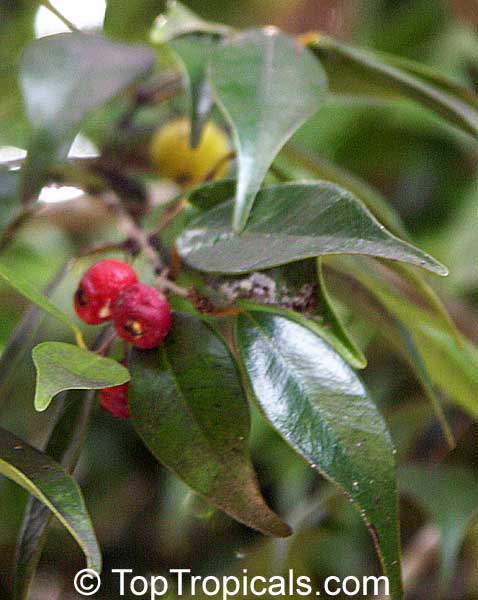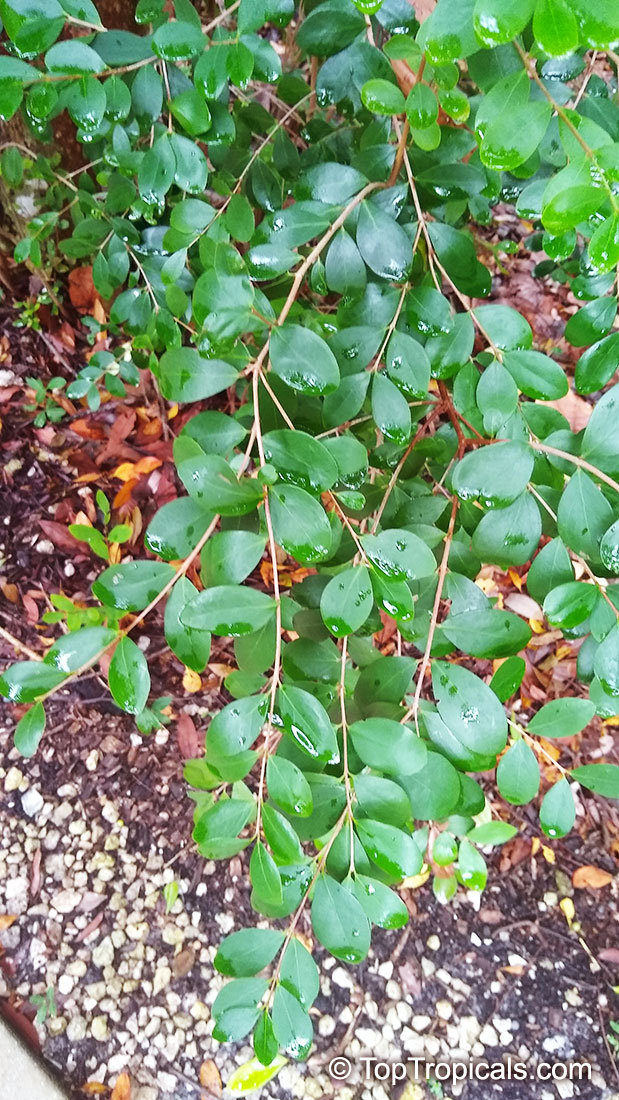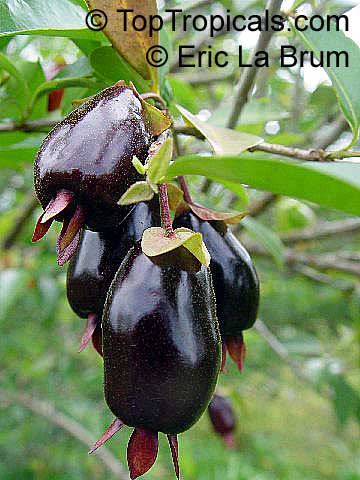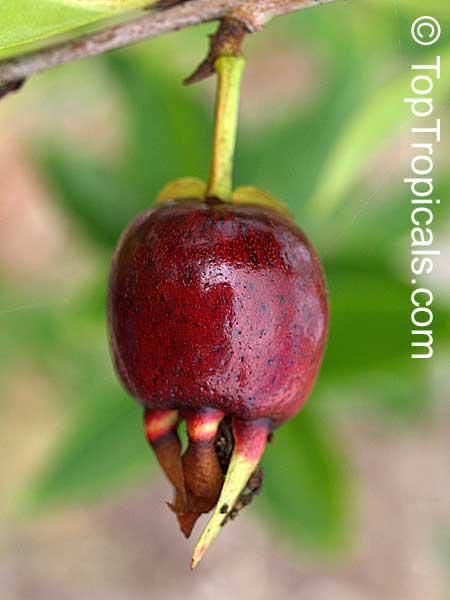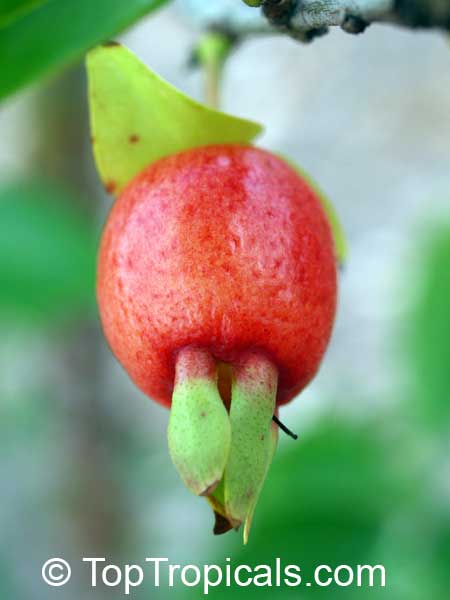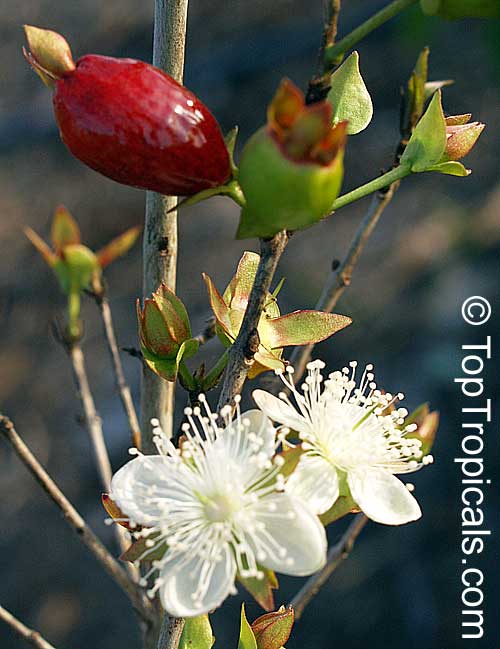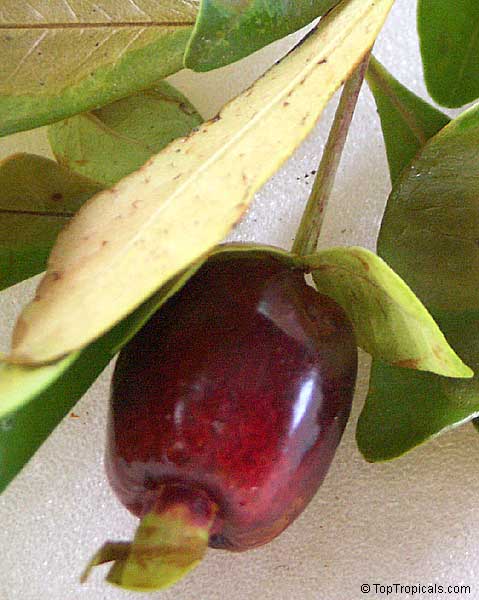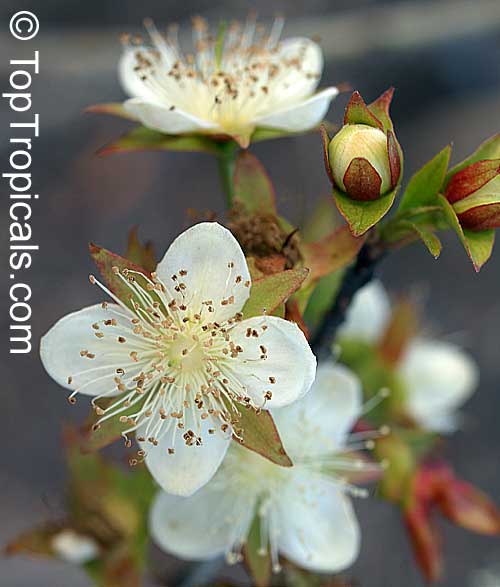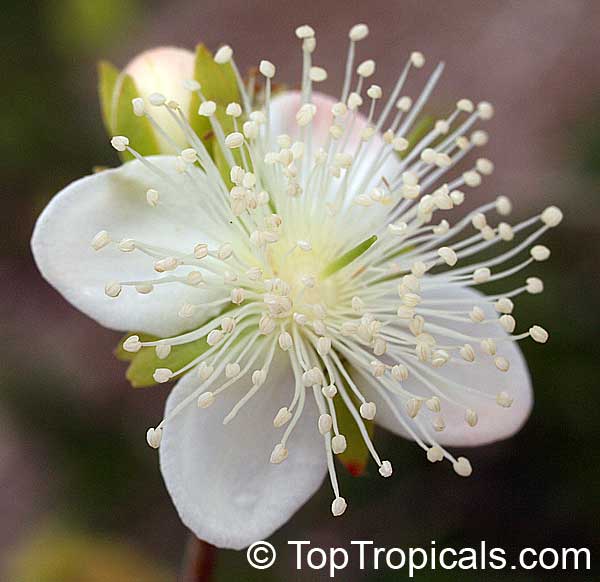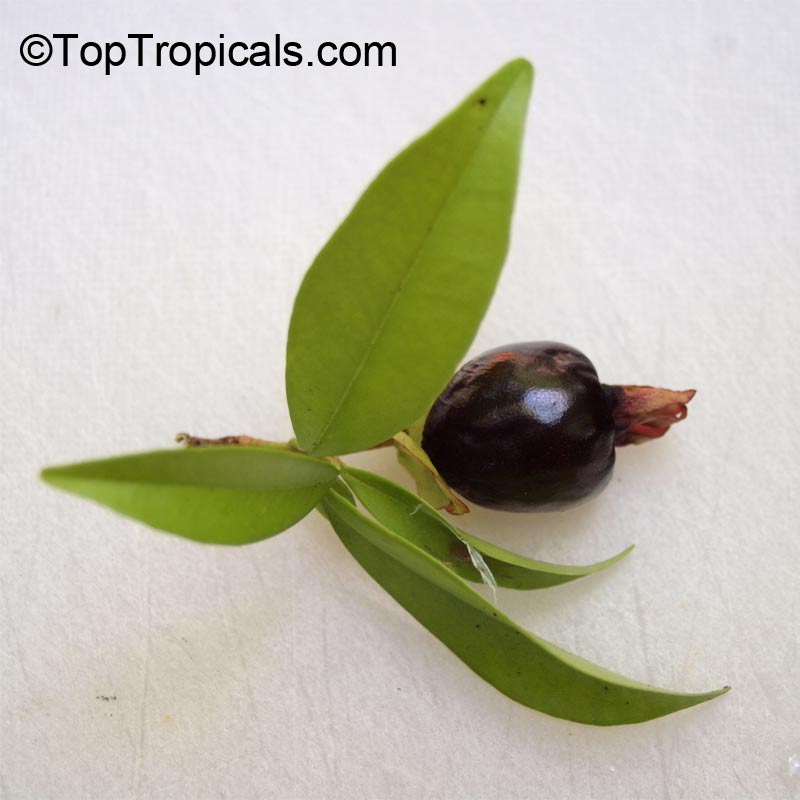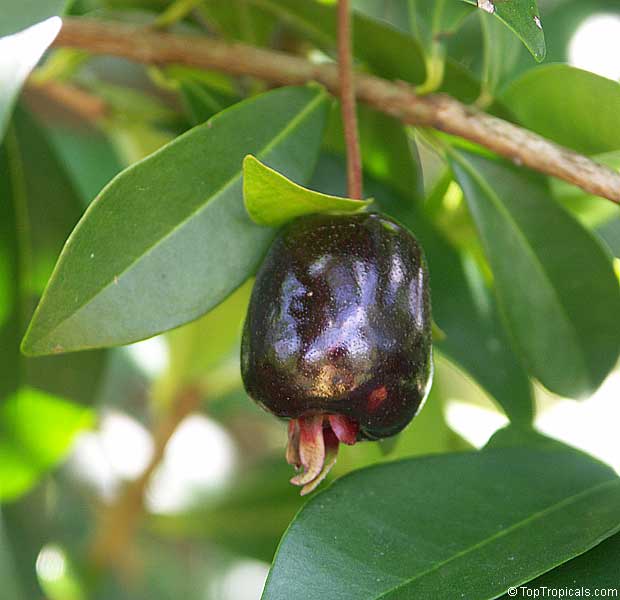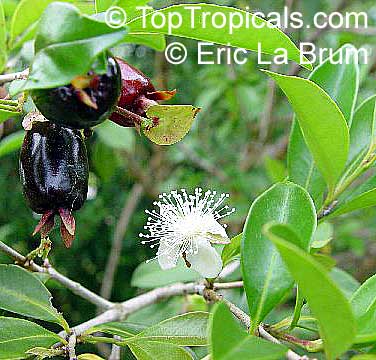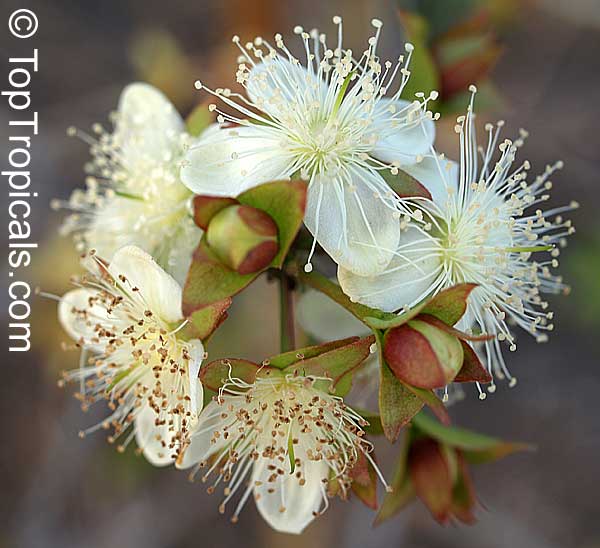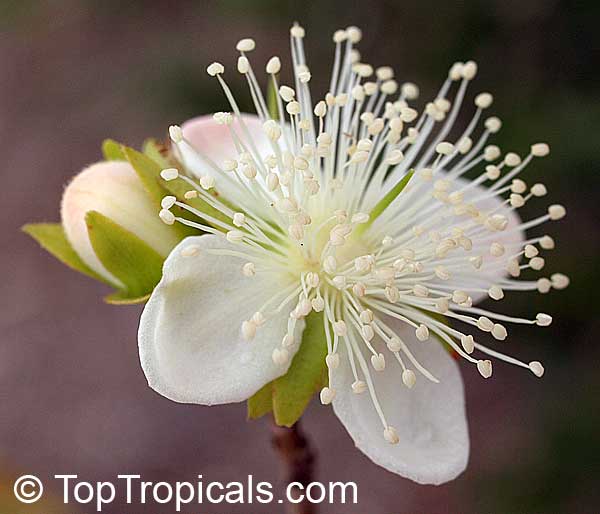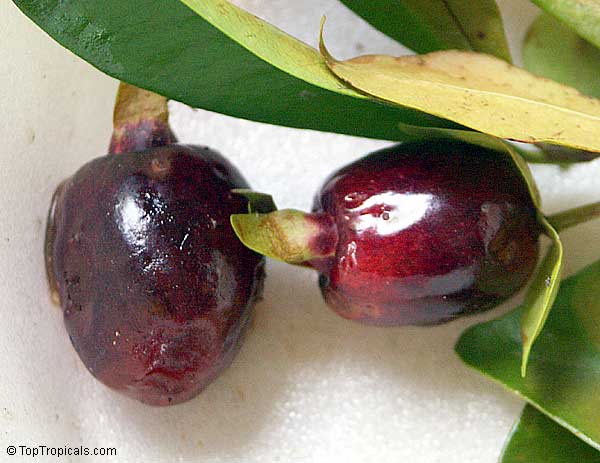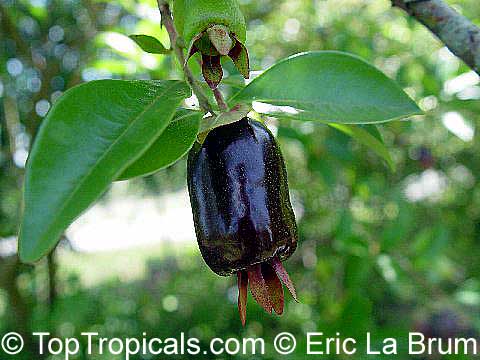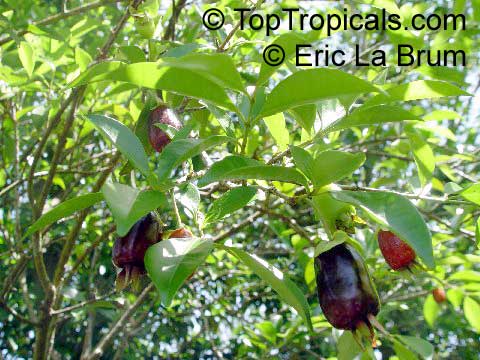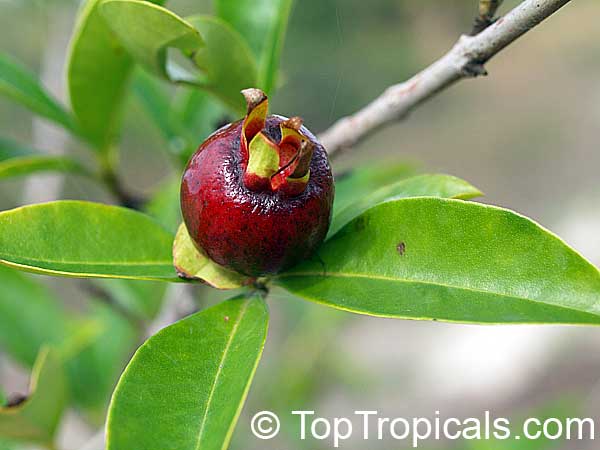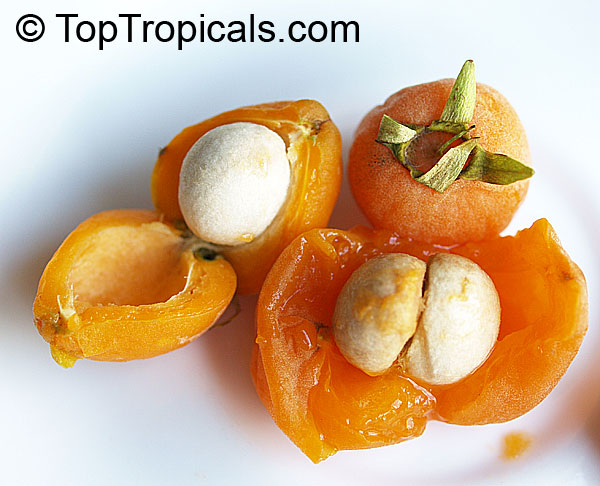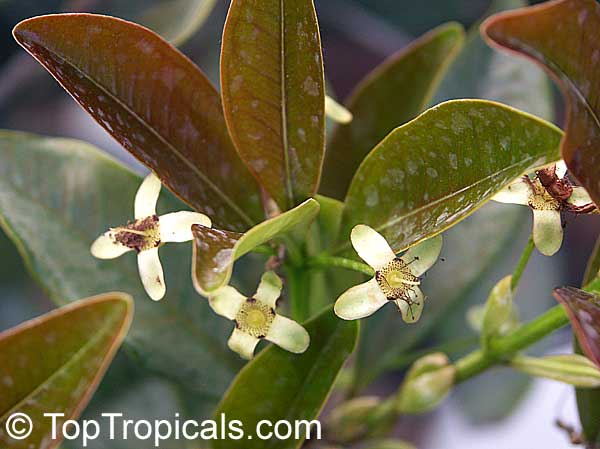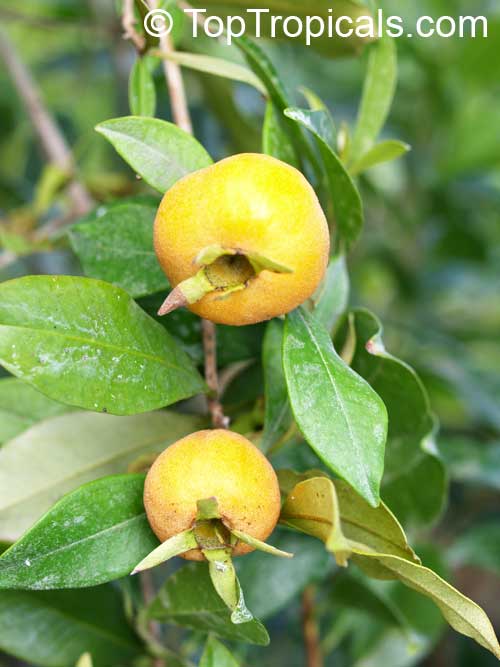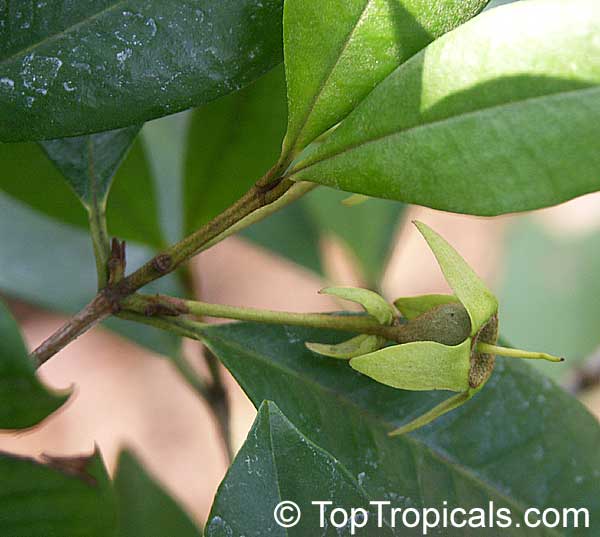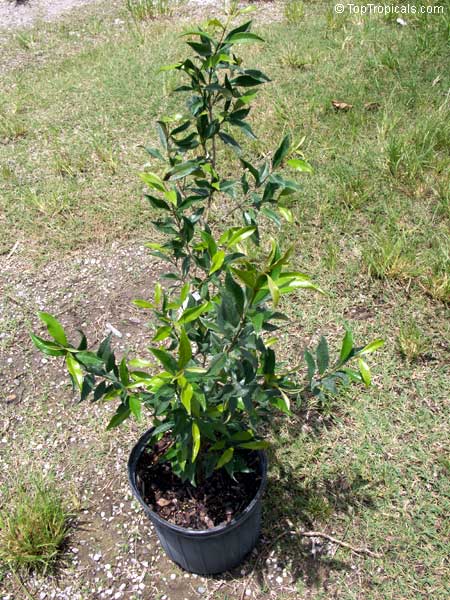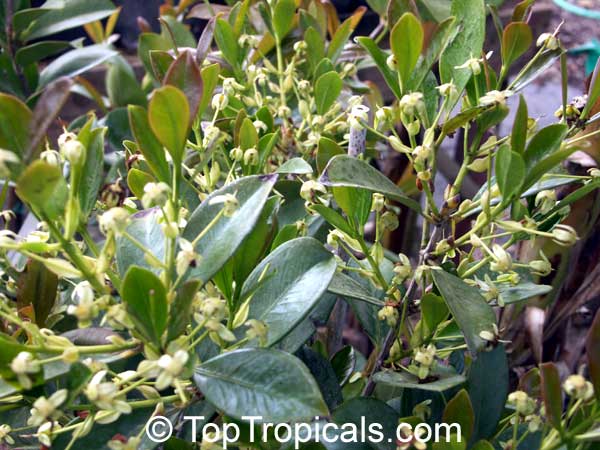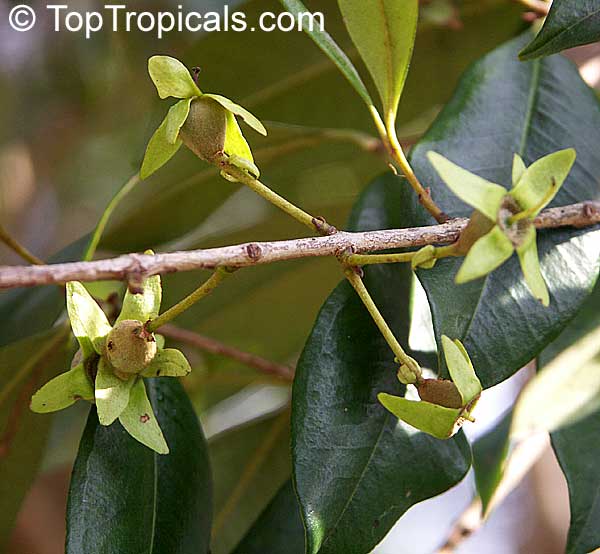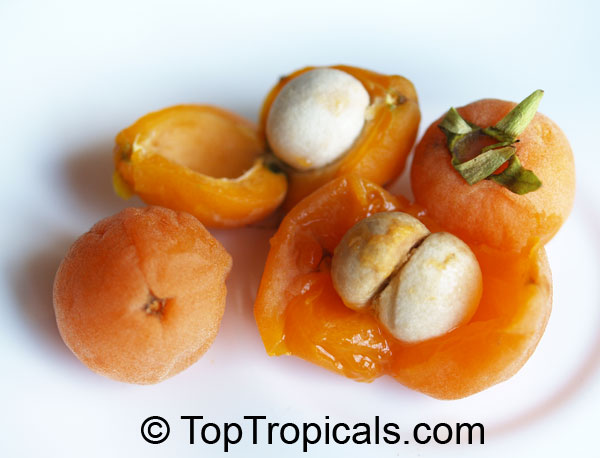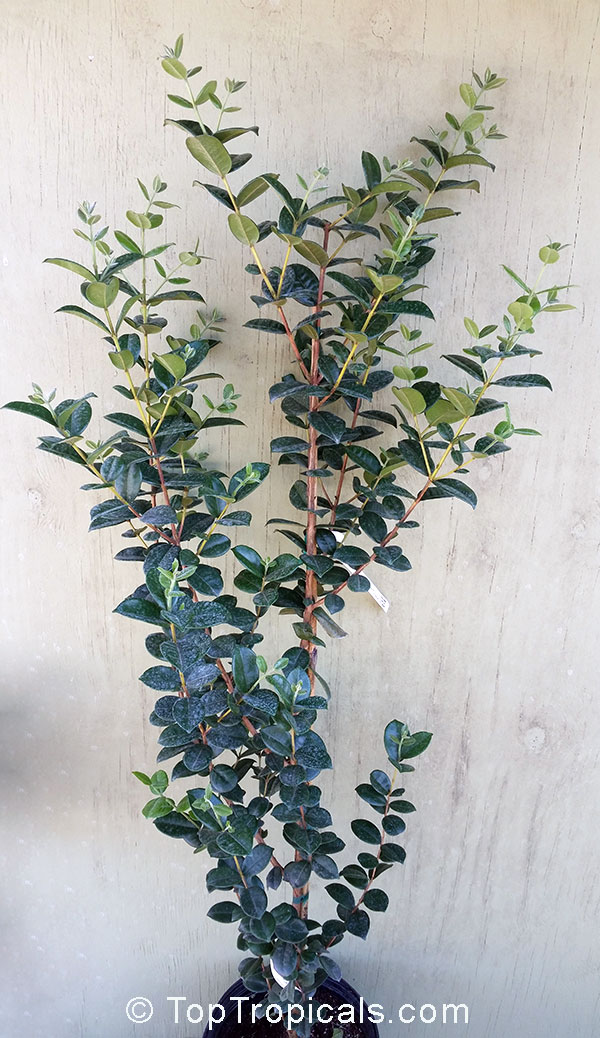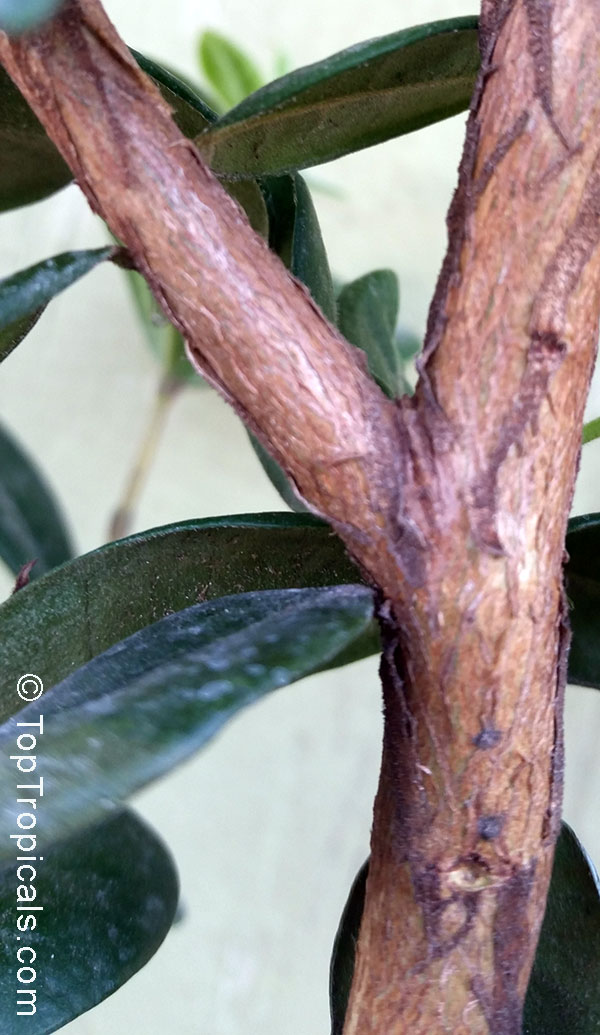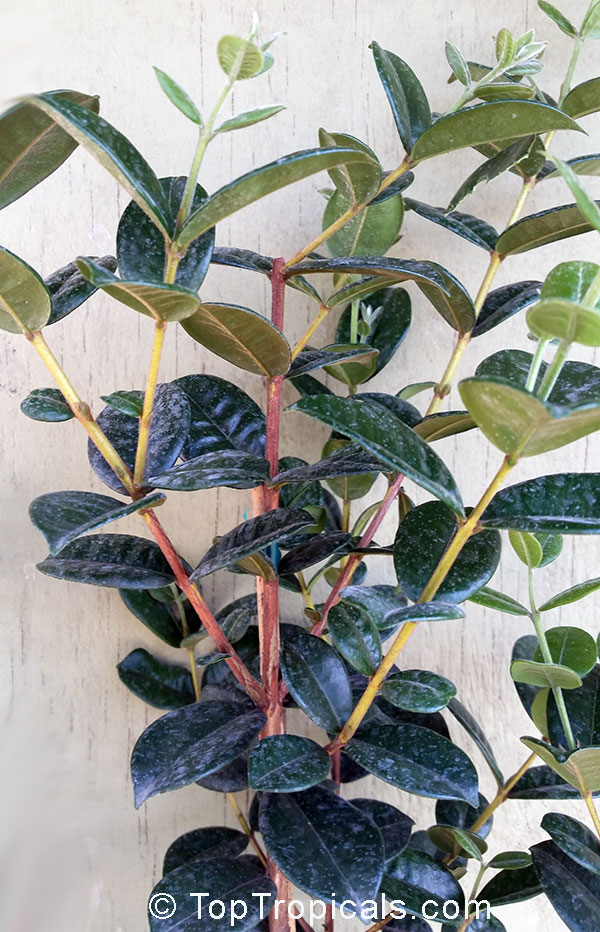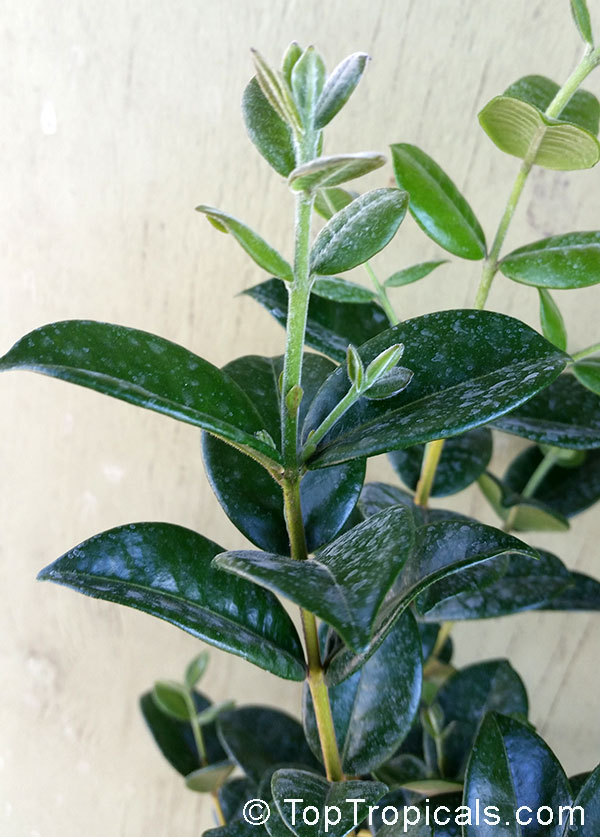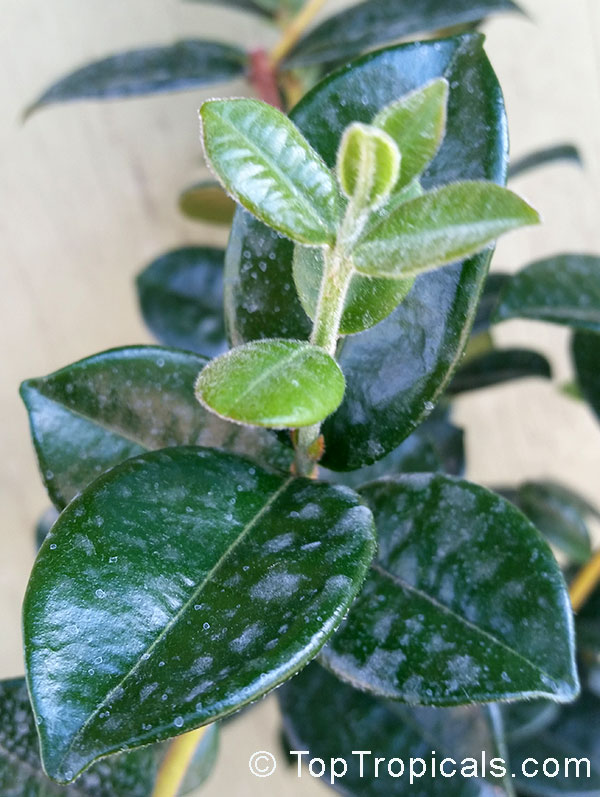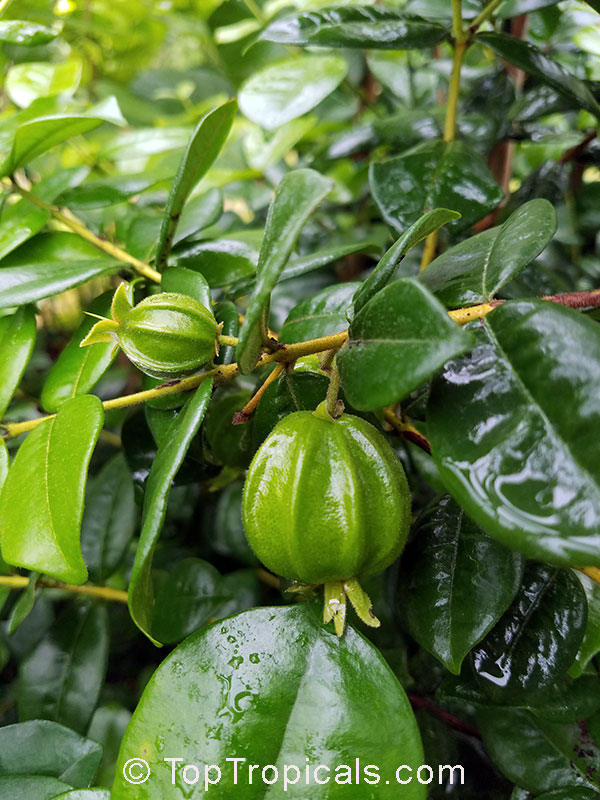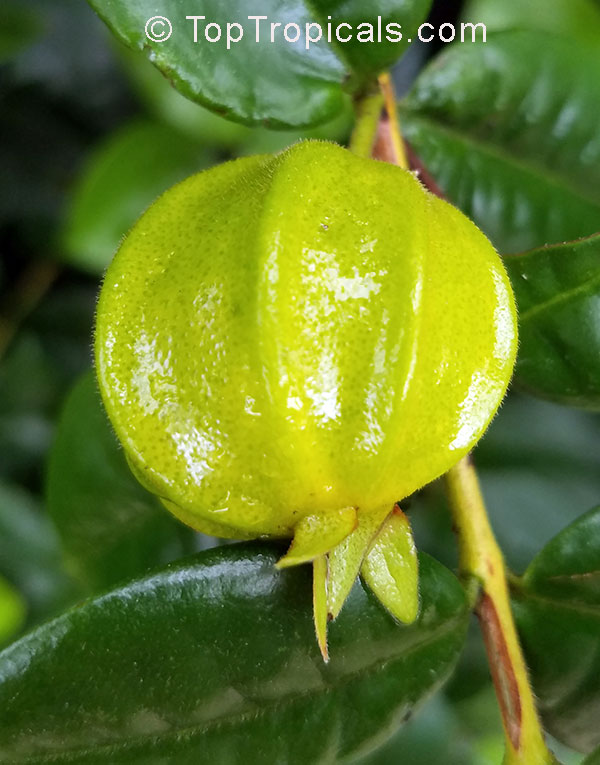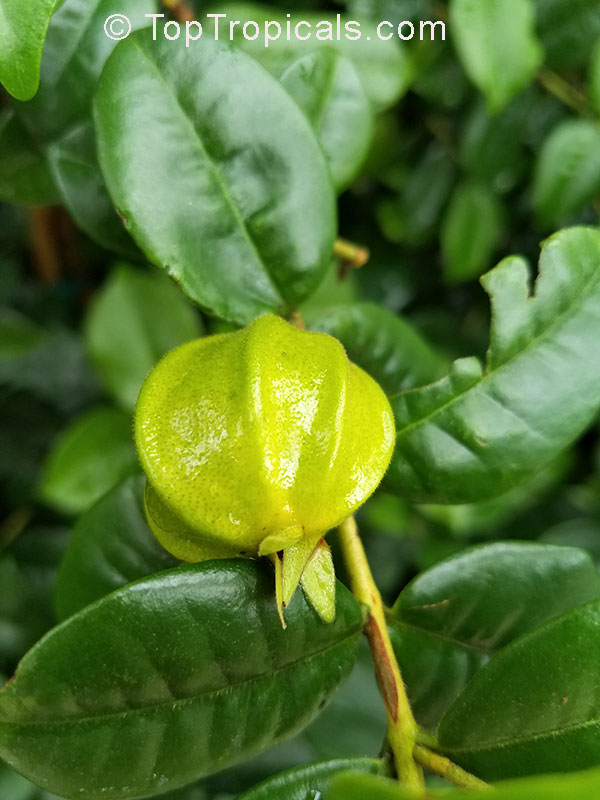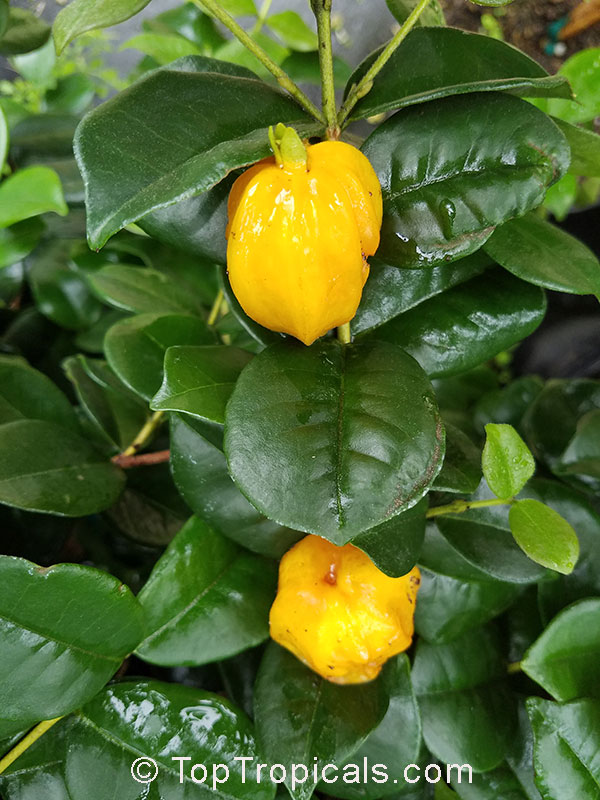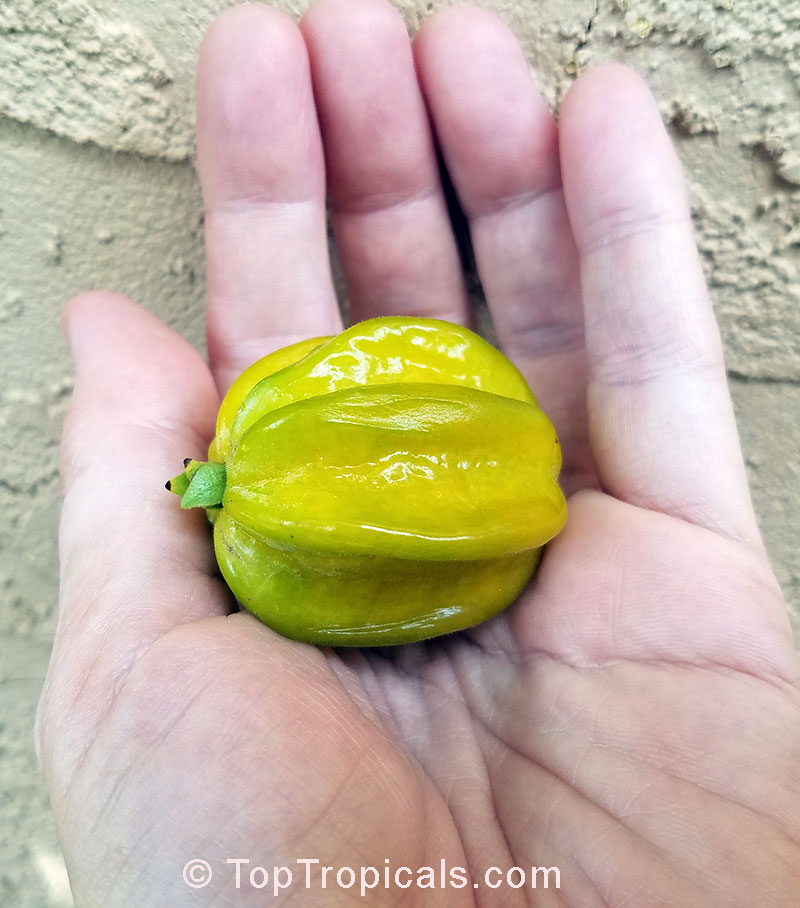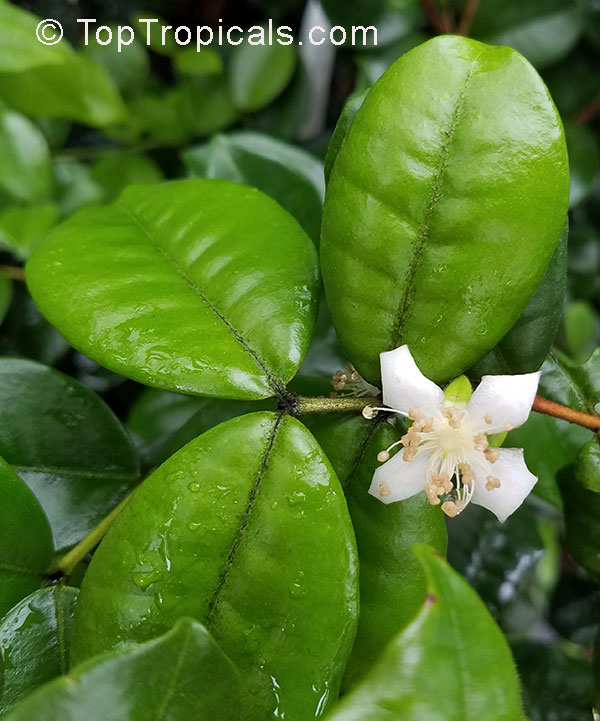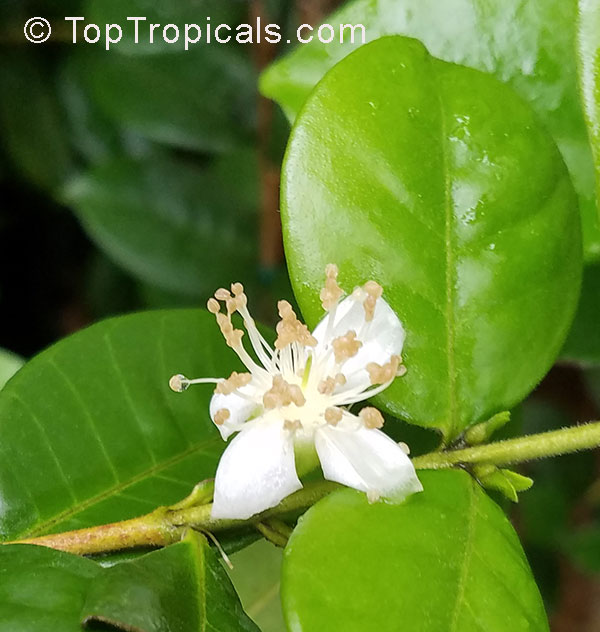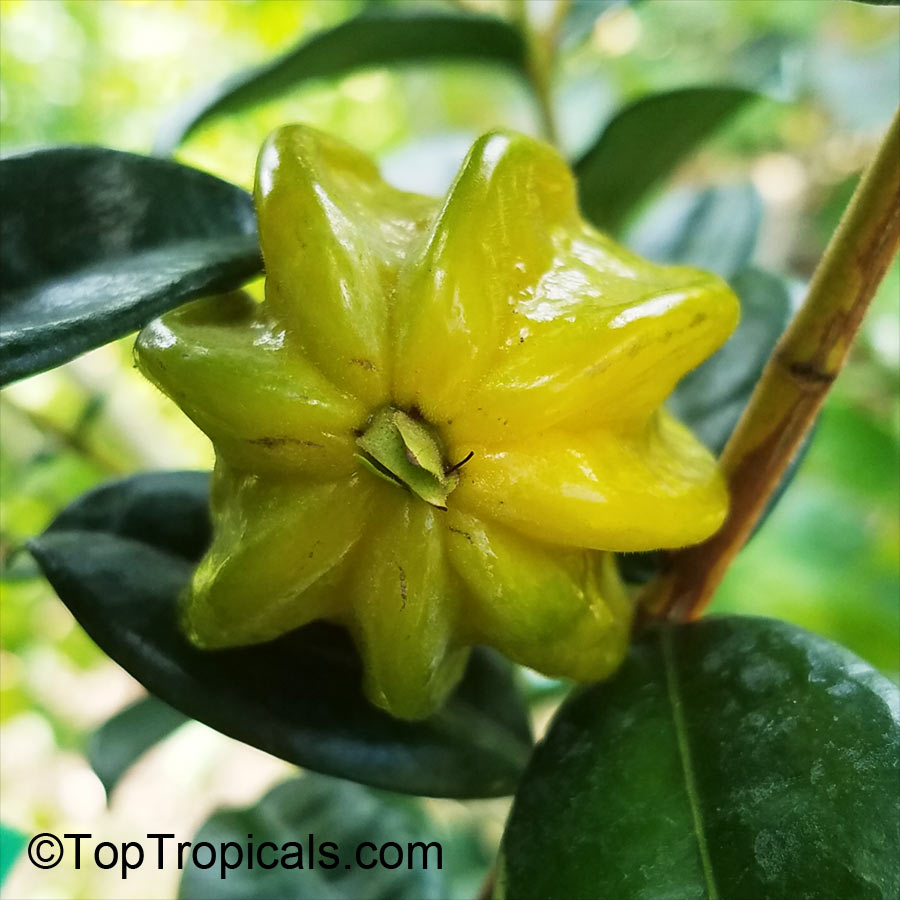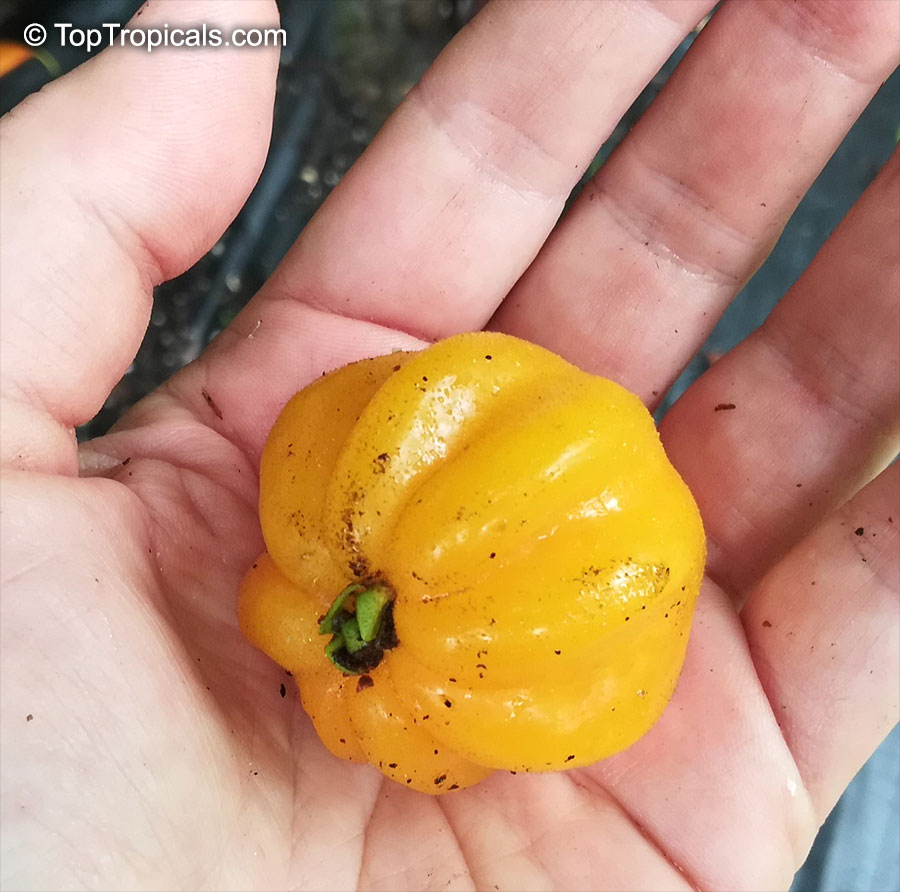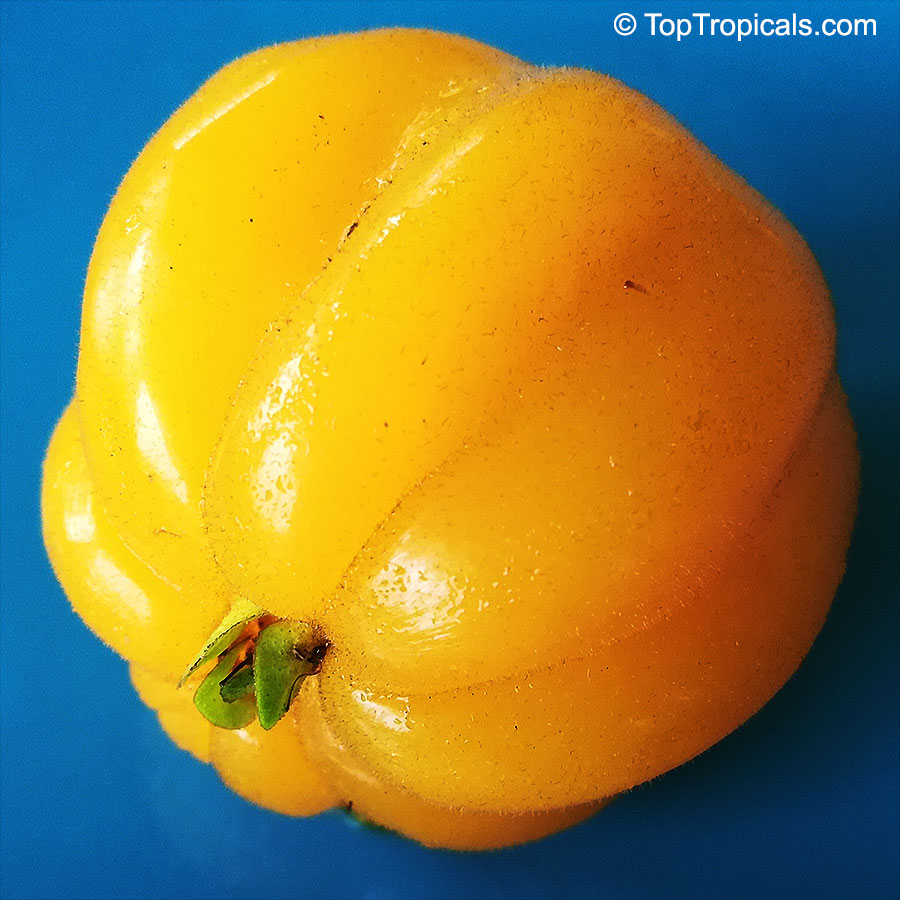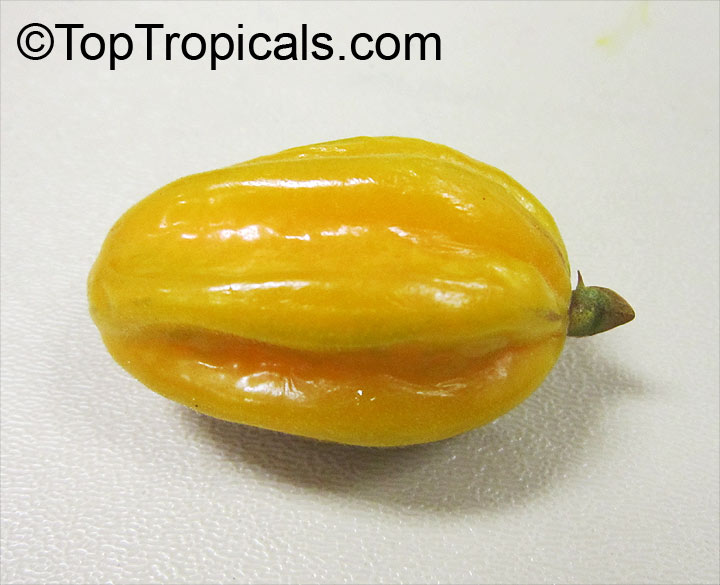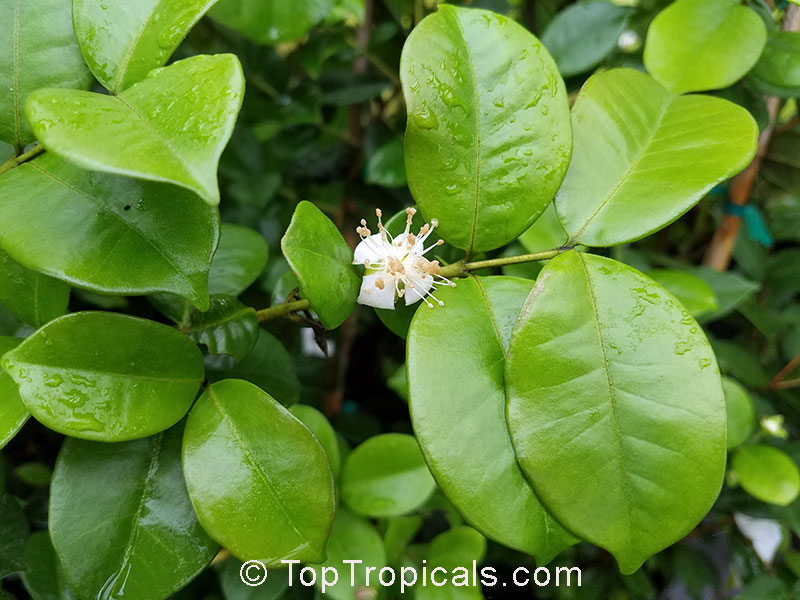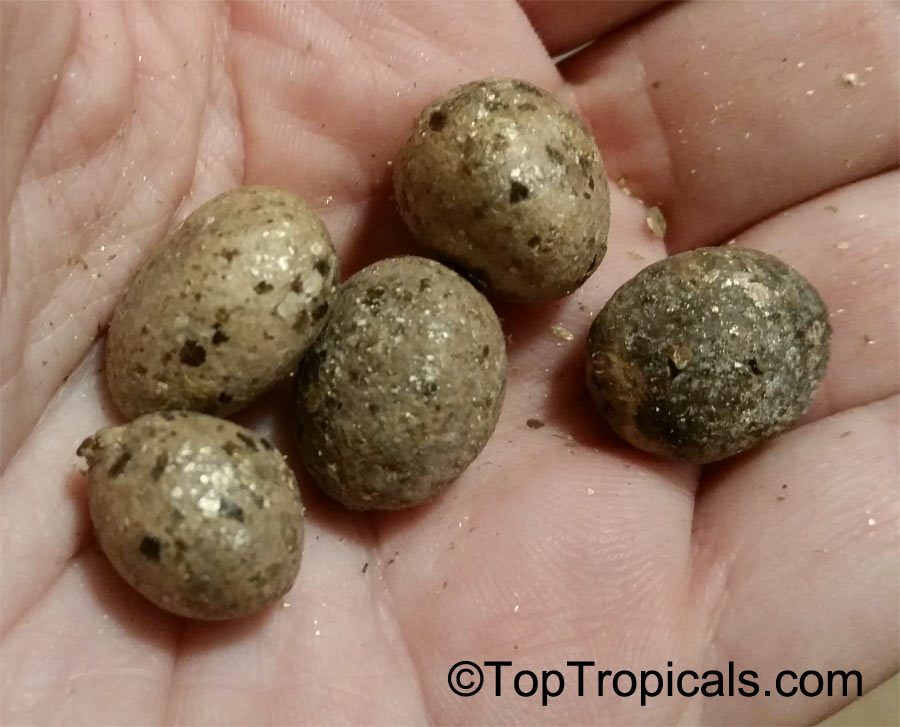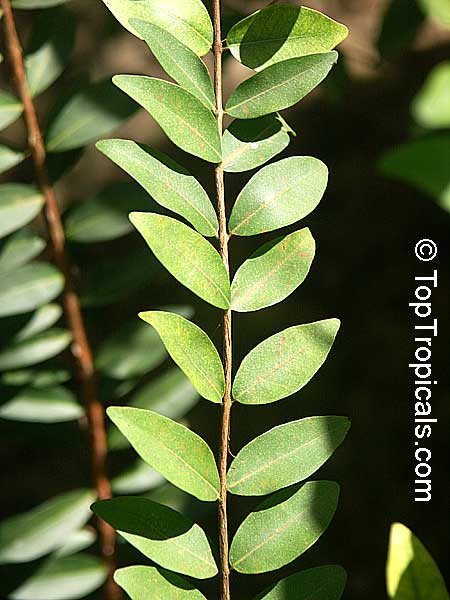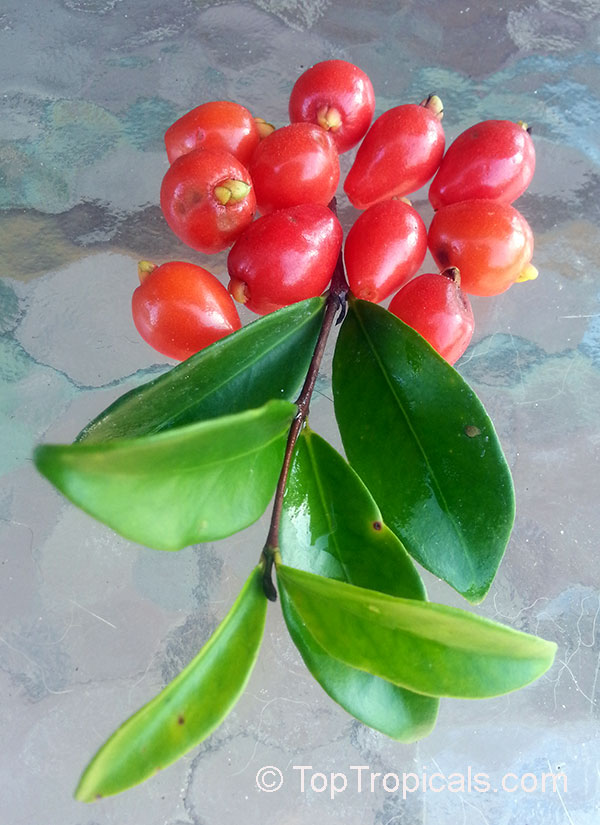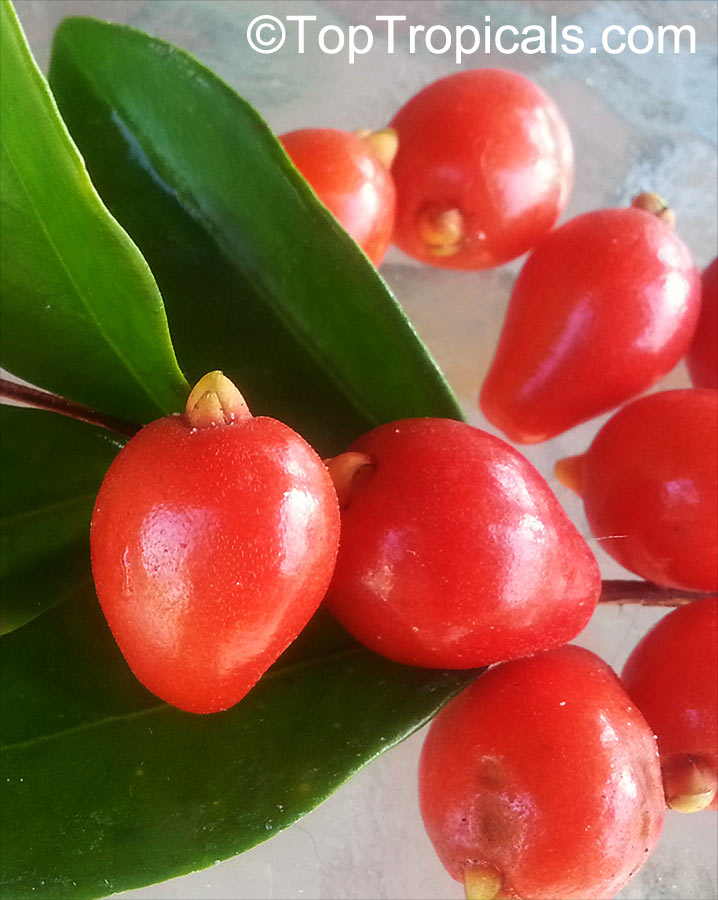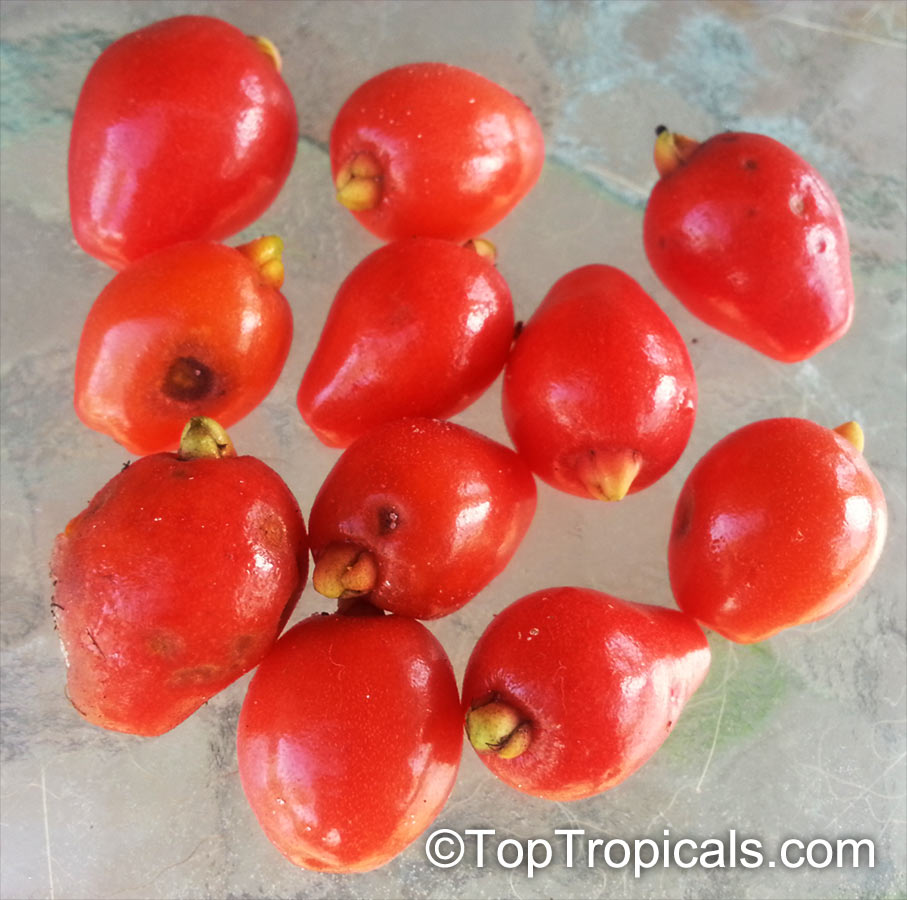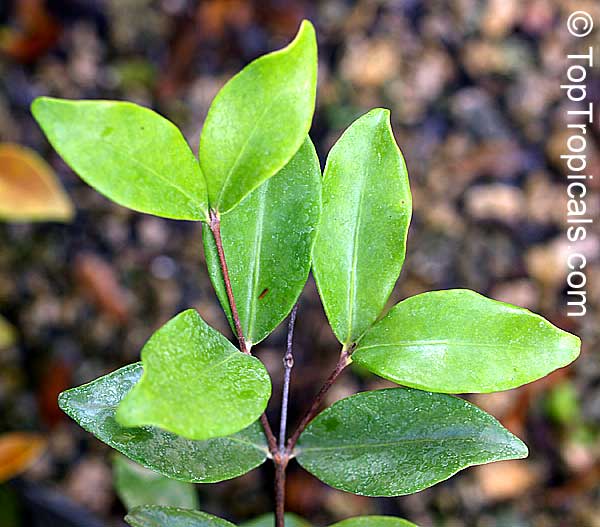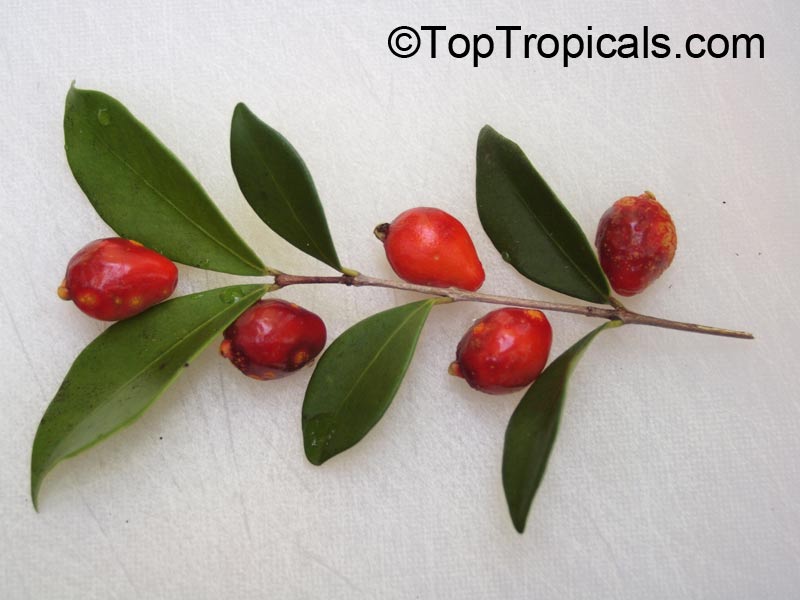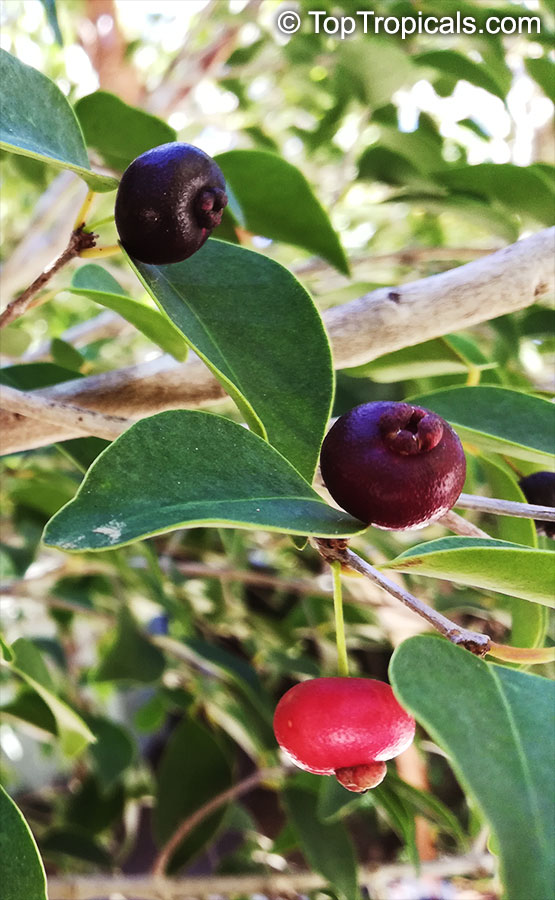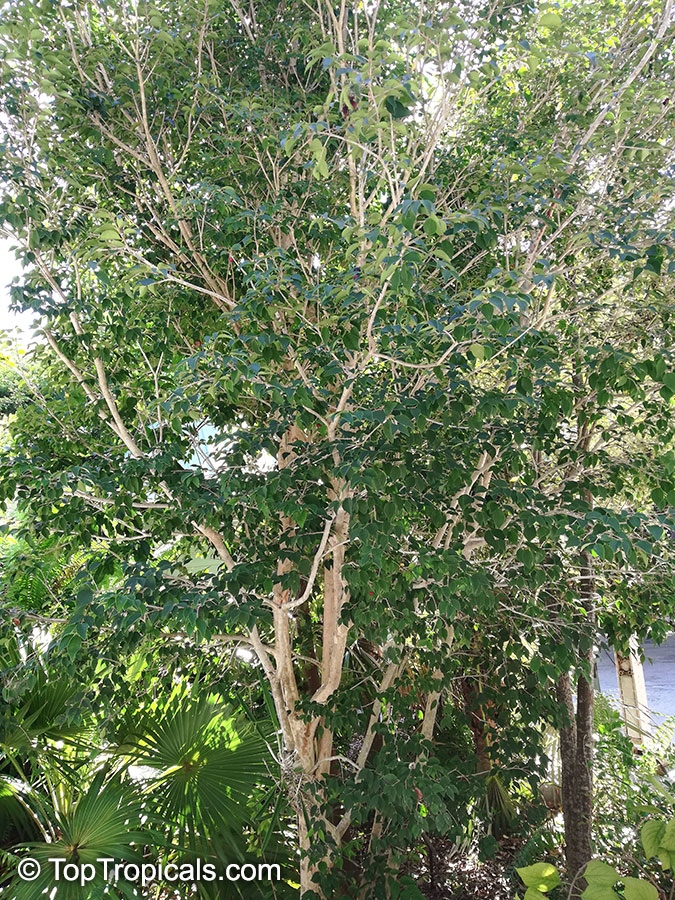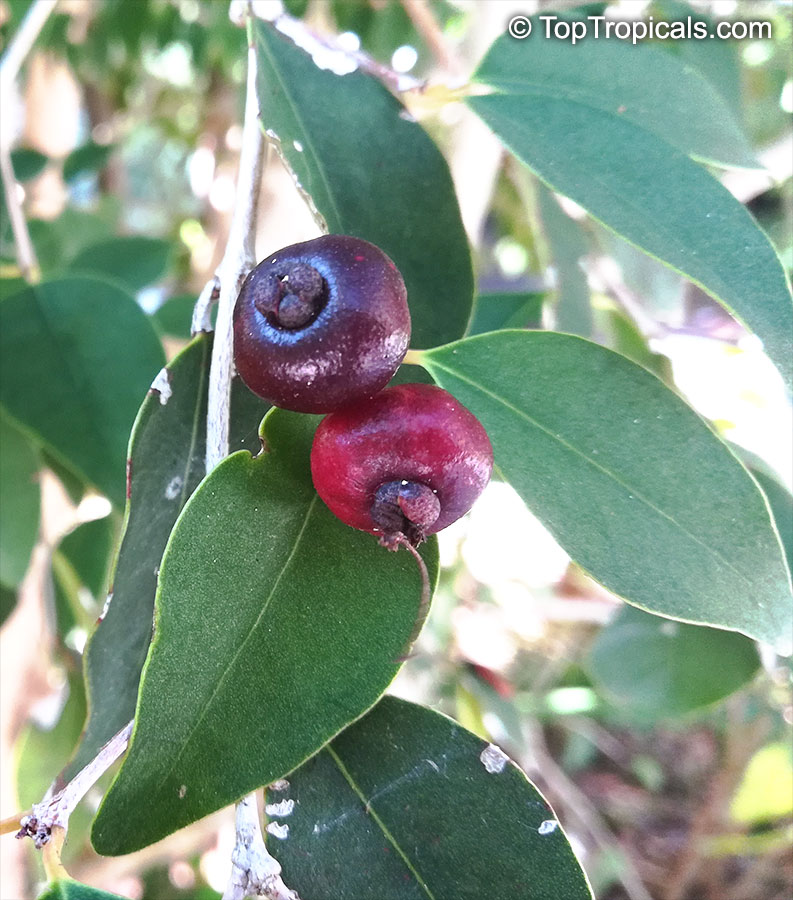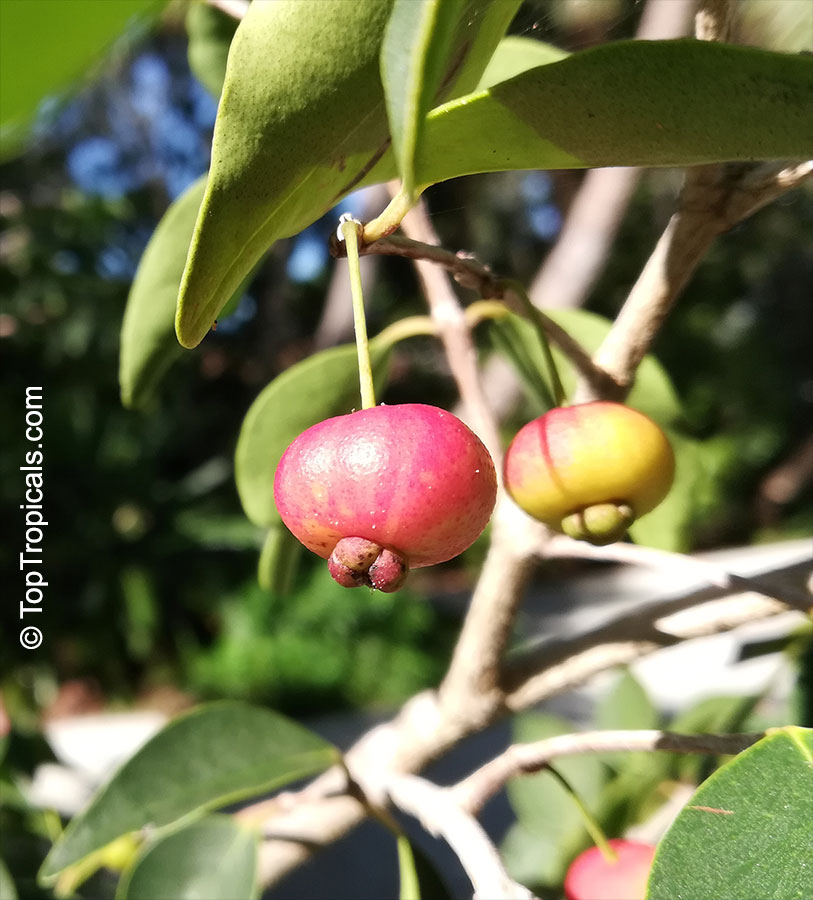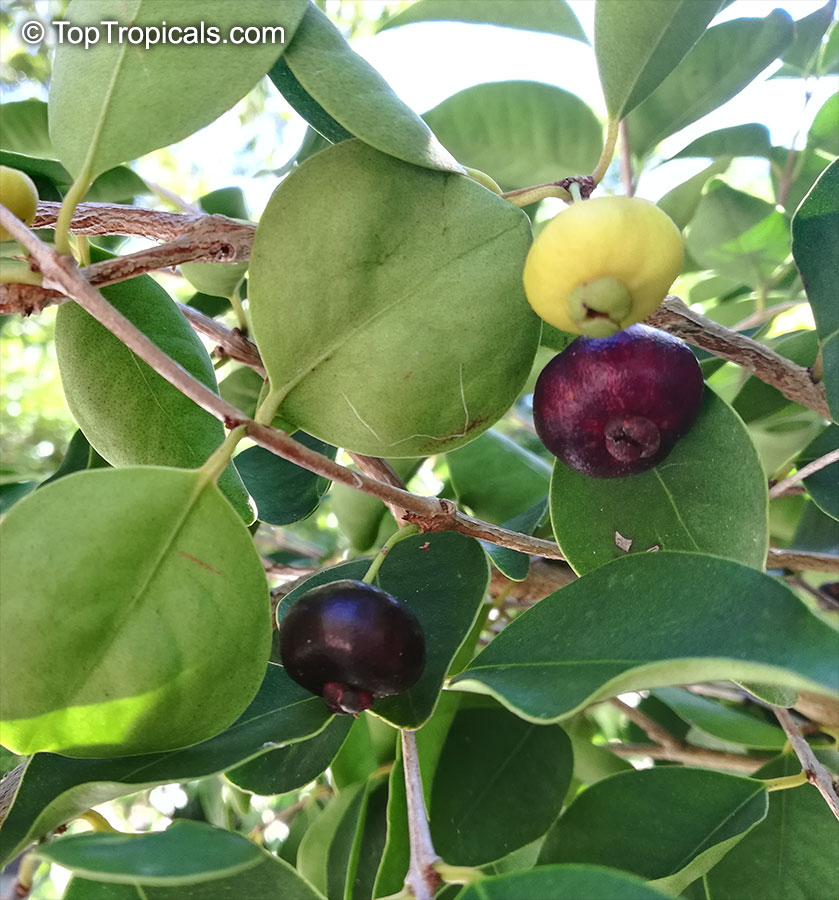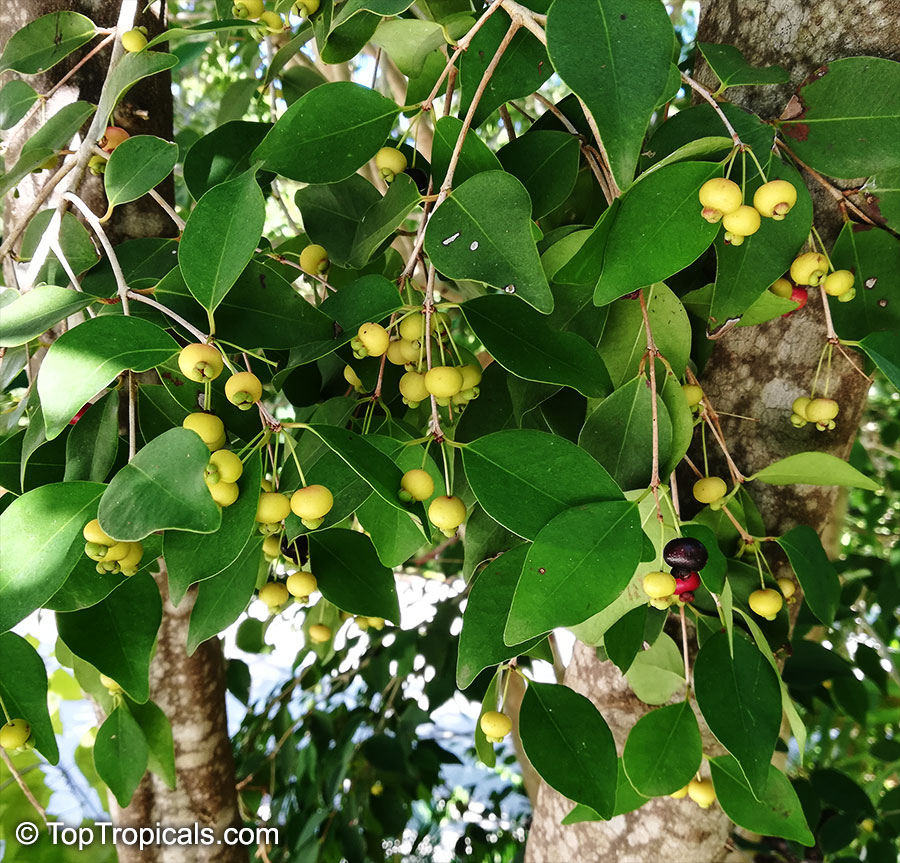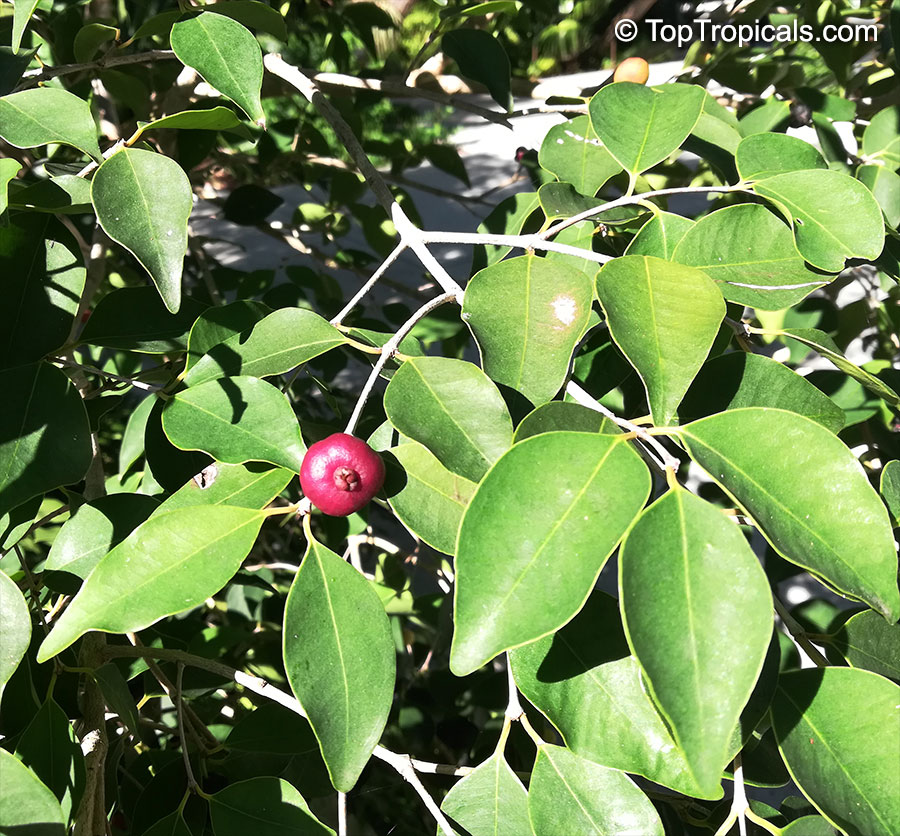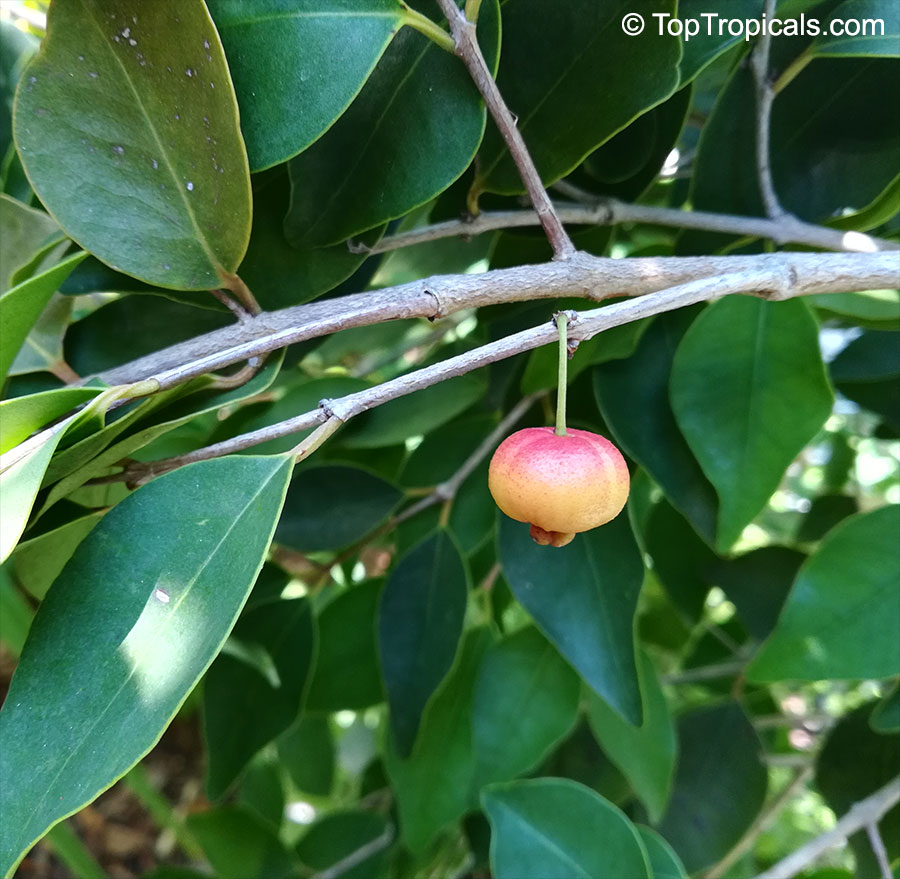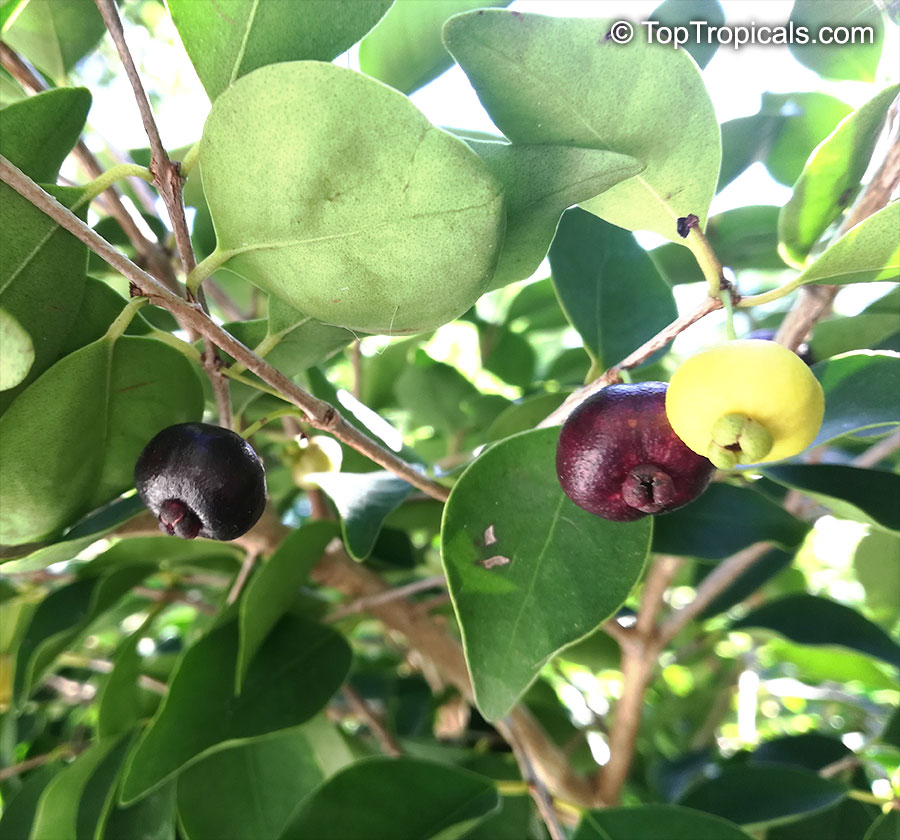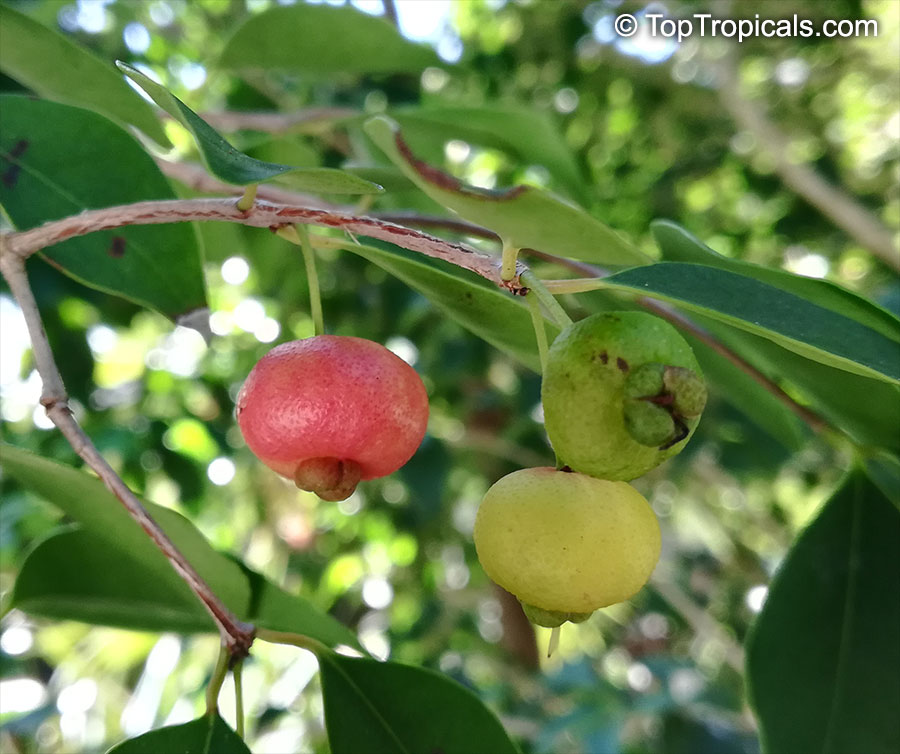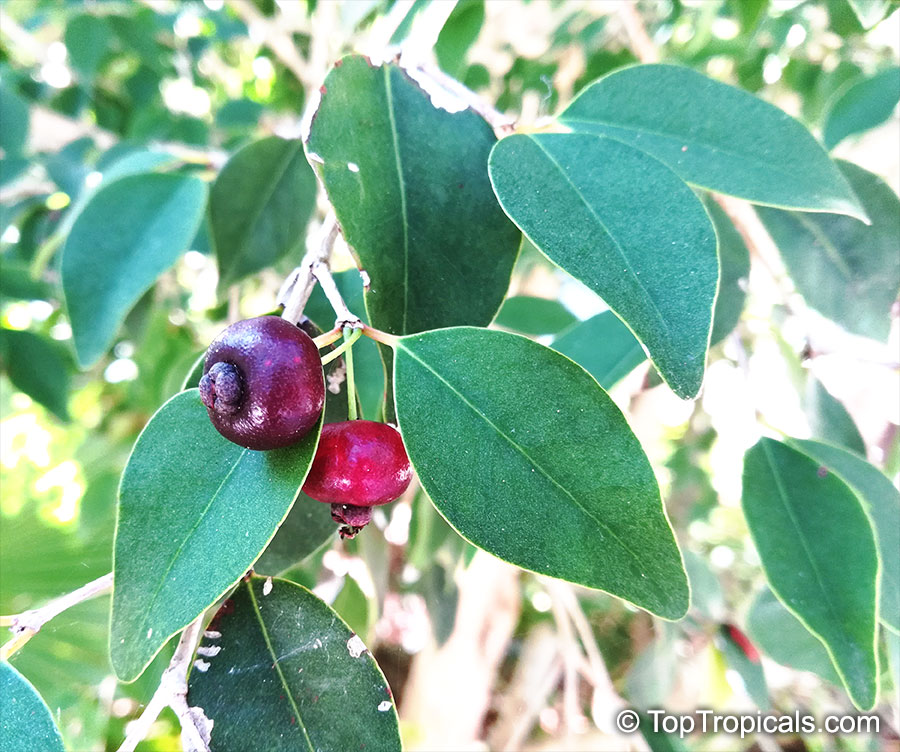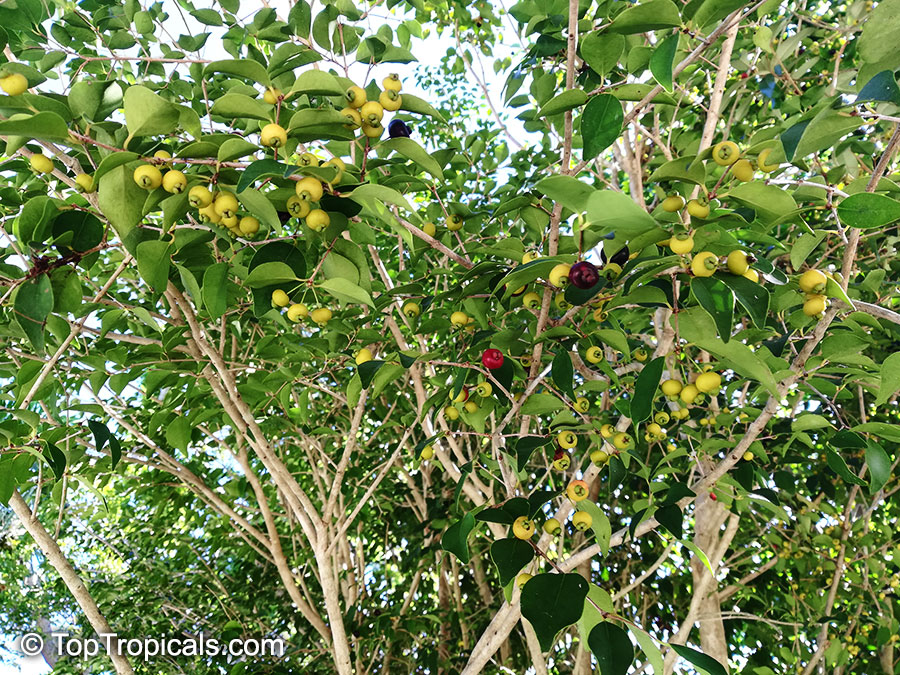Eugenia - Plant Encyclopedia Results
Top Tropicals Plant Encyclopedia
| Number of plants found: 33 | Next | 
|
Go to page: | 1 | 2 | 3 | 4 |
Botanical names: Blepharocalyx salicifolius, Eugenia salicifolia
Common name: Murta
Family: Myrtaceae
Origin: Brazil





Botanical names: Eugenia brasiliensis, Eugenia dombeyi
Common names: Grumichama, Brazilian Cherry
Family: Myrtaceae
Origin: Brazil







Trees are attractive landscape specimens, especially when decked in ripe fruit. Eugenia braziliensis is an ideal choice for sunny and partially shaded seaside communities, tropical and subtropical areas. Although tolerant of hot conditions and fierce sun its fruit are more abundant in partial shade. It can tolerate drought periods, but for best production water deeply during dry spells. Fruits produced by Grumichama are rich in vitamin C and can be eaten fresh or used in making jams and jelly. It is an excellent source of fiber and healthy proteins, making it a great snack choice. A mature plant can produce up to about 500 fruits. Eugenia braziliensis is native to the coastal region of Brazil, yet is perfectly suited for container planting, making it a viable option for even those located in cold regions. As with most tropical trees, it will do best sticking with a combination of full sun and semi-shade. Its moderate water needs also make it an ideal container tree, as frequent watering is not necessary. It should be watered regularly, however, in order to get the best fruit production. They are cold hardy down to upper 20's F, and will take some salt spray.
Recommended Fertilizer: SUNSHINE C-Cibus - Crop Nutrition Booster
SUNSHINE-Honey - sugar booster
Botanical name: Eugenia confusa
Common name: Red Berry Stopper
Family: Myrtaceae
Origin: West Indies







One of the rarest, it tends toward columnar growth. Fragrant flowers, red berries.
Botanical names: Eugenia foetida, Eugenia buxifolia
Common names: Spanish Stopper, Boxleaf Stopper
Family: Myrtaceae
Origin: Florida - West Indies










Eugenia foetida (Spanish Stopper) is native to Florida and the West Indies and can be used for bonsai. This small tree can reach a height of 10-20 feet and requires full sun or semi-shade to thrive. Moderate water is all that is needed to keep it healthy. It produces white, off-white flowers that are also quite fragrant and attract butterflies and hummingbirds. It is also an ethnomedical plant because its fruit was used as a treatment for diarrhea. As a bonus, it is also quite tolerant to salt, so it can thrive in seaside locations. It is hardy in USDA Zones 9-11, so it will be perfect for those who live in colder regions.
When it comes to growing and maintaining this plant, it prefers moist, well-draining, soils and full sun or part shade. Prune it lightly in winter to encourage flower production. This evergreen plant looks best when kept slightly dry and should not be over-watered. During the winter, mulch will help keep the plant warm and can be used to help it tolerate the cold. To keep it in excellent condition, it will need regular fertilization with a balanced slow-release fertilizer. If necessary, prune it in summer to remove dead or damaged branches.
Botanical names: Eugenia involucrata, Eugenia aggregata
Common names: Cherry of the Rio Grande, Cere Jodo Rio Grande
Family: Myrtaceae
Origin: Brazil
Hardiness: 30°F







Eugenia aggregata (Cherry of the Rio Grande) is a small tree or shrub that originates from Brazil, growing between 10-20 ft tall with 2-3 inch long glossy, waxy, dark green leaves that have a center fold. The bark on mature plants peels off, creating a smooth, attractive trunk. It blooms in the spring and continues fruiting through the summer. The edible fruits are dark red to purple, one inch long and oblong, with a full cherry-like flavor. They are excellent fresh, frozen, and used in jams, jellies, and juices.
The Cherry of the Rio Grande is a slow grower, usually adding 2 to 3 feet of height per year. It's best trained as a bush or a small tree that can fit into limited space landscapes, and can even be grown in a container. Propagation is done through seeds and takes 4-5 years to produce fruit. The plant is fairly drought tolerant, but needs regular watering when flowering and fruiting, and should not be over-irrigated as it can cause root resiliency issues. It grows best in slightly acidic soil and is able to tolerate salt spray. The cherry of the Rio Grande is quite hardy, able to handle temperatures as low as the mid-20s F when it is a mature plant, though younger plants should be protected from frost.
The Cherry of the Rio Grande is packed with benefits. It is a rich source of vitamins A and C, iron, calcium, and dietary fiber. It is also believed to help treat throat issues and reduce inflammation. The fruit can grow in clusters of up to 10 and the plant can produce up to 20-50 lbs per year.
Recommended Fertilizer: SUNSHINE C-Cibus - Crop Nutrition Booster
SUNSHINE-Honey - sugar booster
This is a hot seller, limited quantities. This is small plant. Demand is very high, these plants sell faster than we can grow them bigger. Please do not order if size matters to you. Contact us before making purchase if you have any questions
Recommended Fertilizer: SUNSHINE C-Cibus - Crop Nutrition Booster
SUNSHINE-Honey - sugar booster
Botanical names: Eugenia luschnathiana, Phyllocalyx luschnathianus
Common name: Pitomba
Family: Myrtaceae
Origin: Brazil






Eugenia luschnathiana or Pitomba is a slow-growing plant that can reach 15-20 feet in height. It is an attractive ornamental plant with dark green leaves above and lighter green leaves underneath. The trunk is a beautiful light brown and tan color. Pitomba produces white and yellow flowers that are up to an inch and a half in diameter during the spring months. The fruit ripens 4-6 weeks after the flowers appear, with a fruiting season of May to July. The fruit is apricot-colored, round to pear-shaped, and has a soft, melting, juicy flesh with a highly aromatic slightly acidic flavor. It is similar in taste and color to an apricot and is rich in vitamin C. The fruit can be eaten fresh or used to make jelly and preserves.
Pitomba is suitable for container culture or as a dwarf fruit tree specimen. Seedlings take two or more years to begin fruiting. The plant grows well in a variety of soils, but performs best in acidic conditions .This small decorative tree is suitable for planting in USDA zones 9-11 and can be grown in a container in colder regions with proper care. Mature trees are very cold hardy and can withstand temperatures down to the upper 20s Fahrenheit. However, young plants are more sensitive and need to be protected from frost. Pitomba grows best in full sun and requires regular watering and moderate fertilization. It can produce up to 5-7 pounds of edible fruit per tree.
The pitomba fruit offers many health benefits due to its high content of vitamin C and minerals. It also contains dietary fiber and is low in cholesterol and sodium. The pulp of the fruit can be used to make jams, jellies, and juices, as well as being eaten fresh. The seeds, leaves, and bark have traditionally been used in Brazil to treat colds, fevers, and stomach problems.
Recommended Fertilizer: SUNSHINE C-Cibus - Crop Nutrition Booster
SUNSHINE-Honey - sugar booster
Recommended Fertilizer: SUNSHINE C-Cibus - Crop Nutrition Booster
SUNSHINE-Honey - sugar booster
7 gal pot. More developed root system, thicker trunk and branches. Plant height depends on growing season and variety. Dwarf varieties are slow growers and may be shorter. Contact us for exact size description if size/height matters to you. 7 gal plants may be shipped separately from other items by Ground service due to large size. See here time in transit (business days, excluding Sat-Sun!)
Botanical name: Eugenia neonitida
Common name: Pitangatuba
Family: Myrtaceae
Origin: Brazil






Pitangatuba - native of Rio de Janeiro. It looks like a giant yellow cherry. The taste, however, is nothing bitter, and resembles that of Uvaia (Eugenia pyriformis). Great potential for pulp production, is much richer in vitamins and minerals than other cherries. Until recently is was almost unknown to the fruit growers. In its natural habitat, is a compact shrub, from 4 to 6 ft. Its trunk has a rough outer shell, it gives off in plates. The leaves are leathery, dark green on the upper surface and lighter on the bottom. The ribs are well printed on top. Very slow growing, but can be quick to flower. 2-3 year old plants can flower and fruit when barely a foot tall. Foliage and flowers have similarities to the Eugenia uniflora and the shrub makes an attractive ornamental.
Bright yellow fruit is oblong, 2-3" size, like a giant cherry, thick pulp, acidic and very juicy and aromatic. Flavor is pleasant, making it sweeter when grown in full sun.
Tolerant to salt wind conditions. Excellent container plant.
Botanical name: Eugenia pyriformis
Common names: Uvaia, Uvalha, Uvaia-do-mato, Uvaieira
Family: Myrtaceae
Origin: Brazil







Eugenia pyriformis (Uvaia) is a species of tree that is native to Brazil, sometimes referred to as "big tree/ tall tree". It is often grown as an ornamental tree as it can typically grow to be taller than 20 ft. When it comes to the growing requirements of this plant, Uvaia needs to be placed in areas that are exposed to full sun or semi-shade. It is important to water this tree regularly. It grows best in USDA Zone 9 to 11.
The Uvaia tree is a very special tree as it produces edible fruit. The fruit itself is sweet and aromatic with a tart taste. It is very commonly used for its juice, which is produced commercially in Brazil. In addition to the juice, the crushed leaves of this tree give off a spicy odor when crushed. Additionally, research suggests that the fruit has many health benefits and is considered to be a powerful remedy for certain ailments. It is known to contain high levels of Vitamin C and help in aiding digestion, improving heart health and providing a boost to the immune system.
Botanical name: Eugenia reinwardtiana
Common names: Beach Cherry, Cedar Bay Cherry
Family: Myrtaceae
Origin: Eastern Australia
Hardiness: 30°F










Eugenia reinwardtiana (Beach Cherry) is a compact shrub or small tree native to eastern Australia, valued for both ornamental and edible qualities. It typically grows 5 - 10 ft tall and thrives in full sun to partial shade with moderate watering. In warm climates (USDA Zones 9-11), it can be planted in the ground, where its dense foliage makes it ideal for a seaside hedge, and it can also be trained as a bonsai or grown in large containers.
In spring and summer, Beach Cherry produces clusters of small white to creamy-white flowers, similar to those of other lilly pillies, followed by attractive red fruits. The sweet, soft-fleshed berries are enjoyable fresh and may be used in jams, desserts, or other dishes. A mature, well-cared-for plant can yield abundant harvests.
Beach Cherry prefers well - draining soil and benefits from protection against extreme cold. In cooler regions, container plants can be overwintered indoors in a bright, sheltered location, with careful monitoring to avoid overwatering. Salt tolerance makes it well suited for coastal gardens, adding beauty, versatility, and a productive element to the landscape.
Recommended Fertilizer: SUNSHINE C-Cibus - Crop Nutrition Booster
SUNSHINE-Honey - sugar booster
Botanical name: Eugenia rhombea
Common name: Red Stopper
Family: Myrtaceae
Origin: North America







Eugenia rhombea, commonly known in Florida as "Red Stopper", is one of four species of Eugenia native to North America. It is a beautiful small tree, bearing small shiny deep green leaves which are pinkish-orange-red when young, giving them the appearance of a flowering tree at a distance when flushing out new growth a number of times a year.
Its native range includes Florida, Bahamas, Cuba, Hispaniola and part of Eastern Central America. However, here in Florida, it is federally listed as an endangered species, only known from the lowermost Everglades and Keys, where even there it is rare.
These elegant little trees grow to perhaps 12 or so feet tall, developing an elegant, umbrella shaped canopy. At a distance, they rather resemble Ficus benjamina, yet with a more orderly and refined appearance. In addition, they develop fluffy white flowers with a delightful fragrance, followed by holly-like long lasting red berries which are relished by wonderful song birds.
Although appearing delicate, this tropical species is surprisingly hardy, and would likely even make striking, a one-of-a-kind houseplant in the North.
| Next |  |
Use link to repeat this search:
https://toptropicals.com/cgi-bin/garden_catalog/cat.cgi?find=Eugenia&search_op=and&keyword_op=and&language=e&number=10
&no_change_lang=1&user=tt&sale=1&first=0
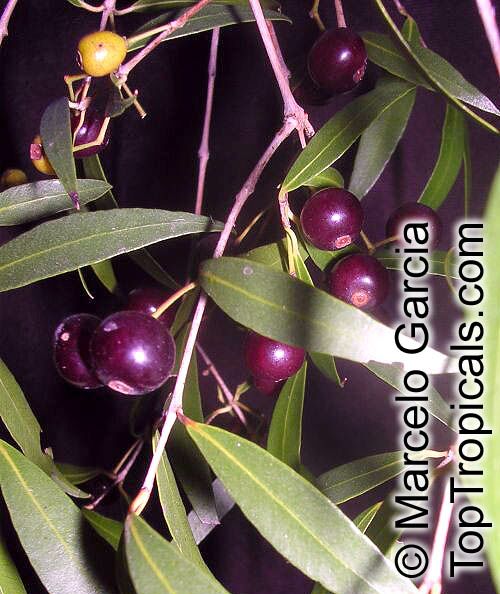
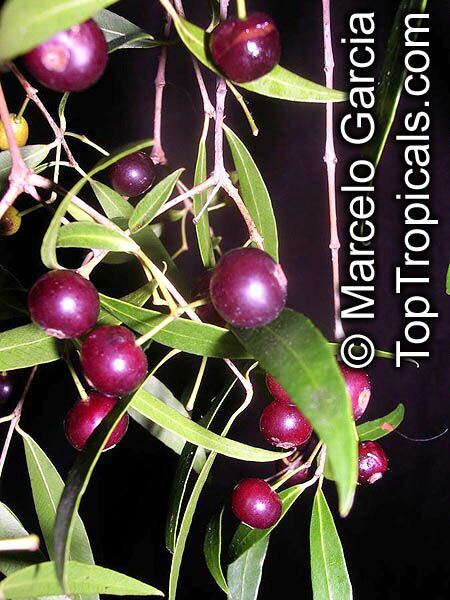
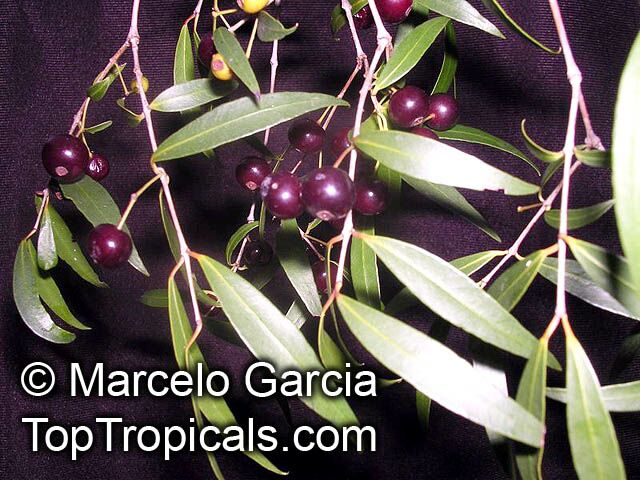
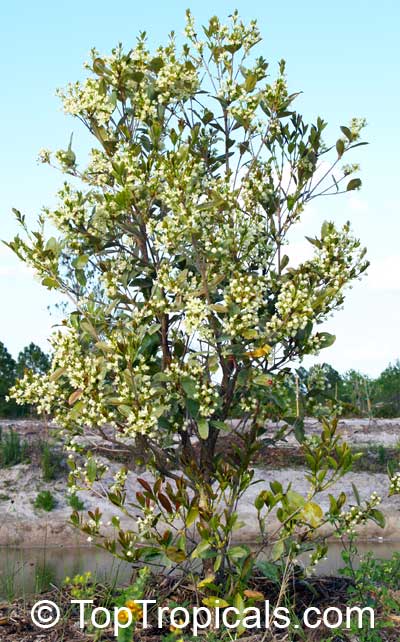
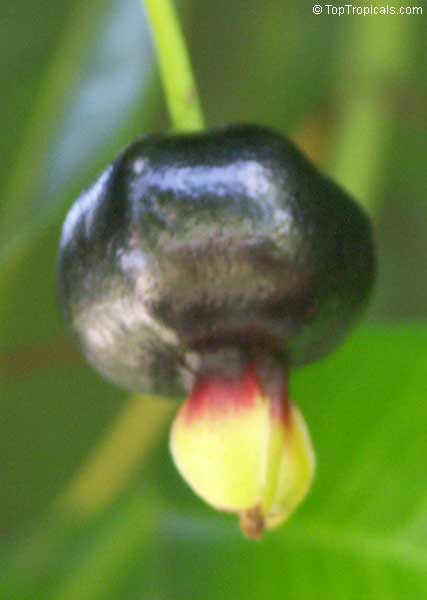
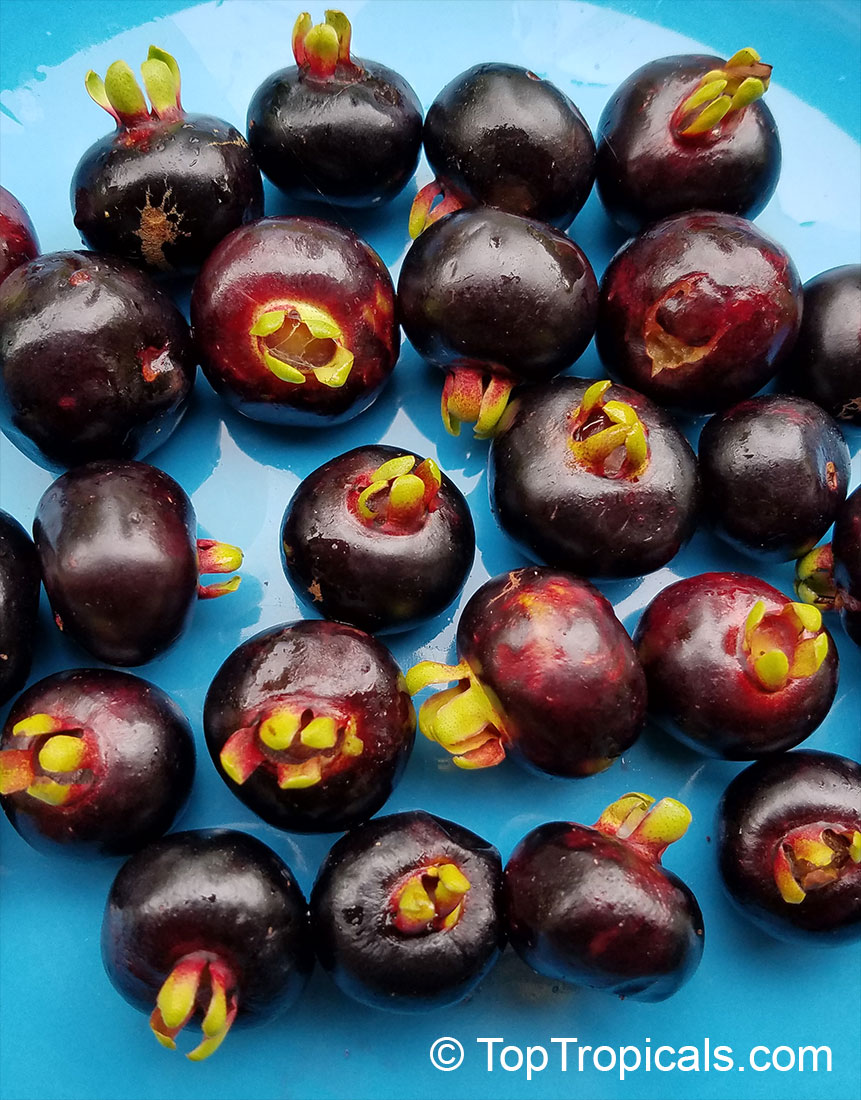
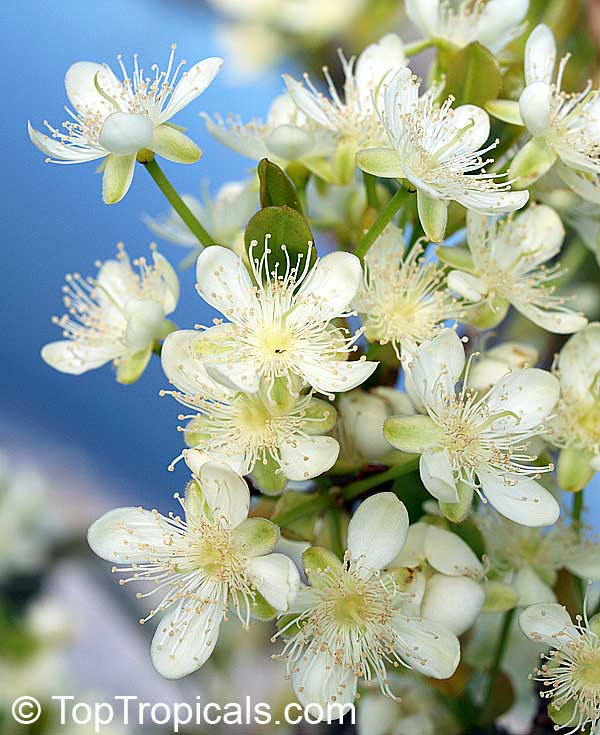
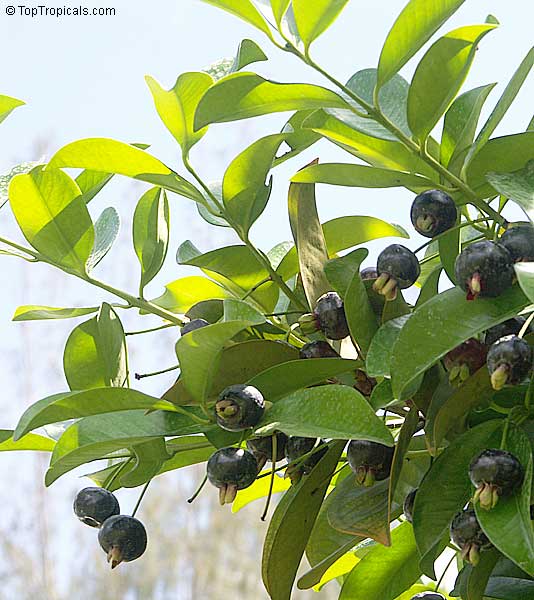
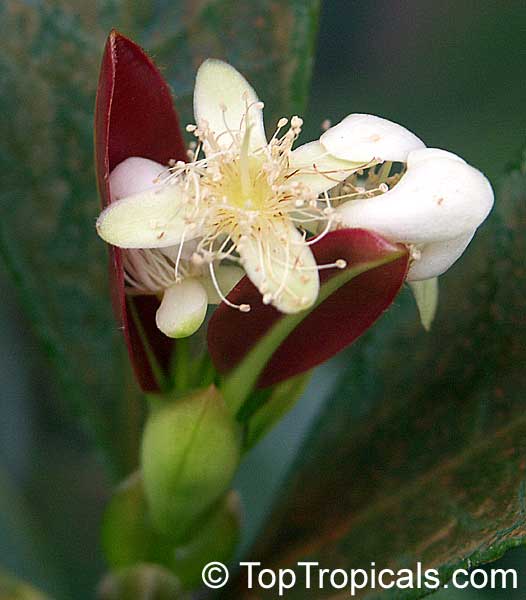
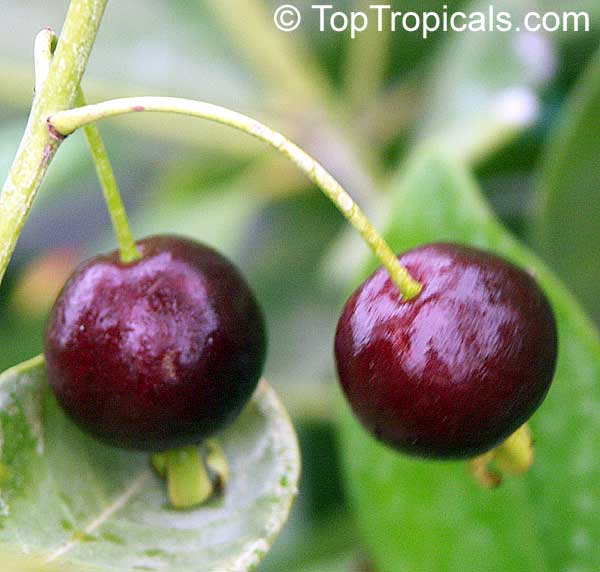
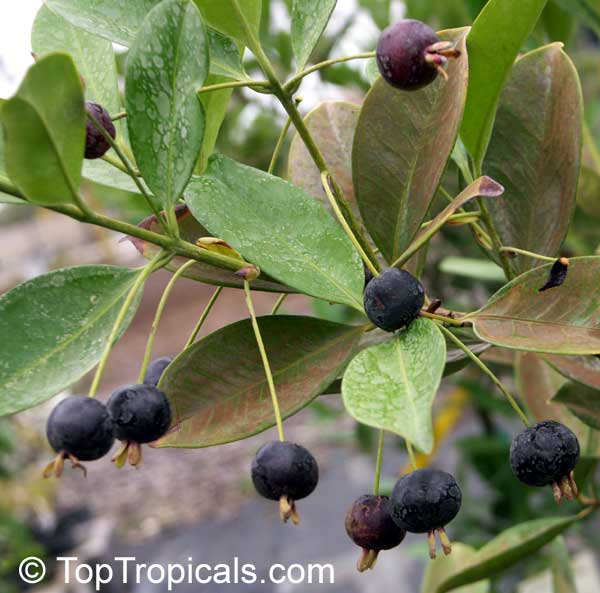
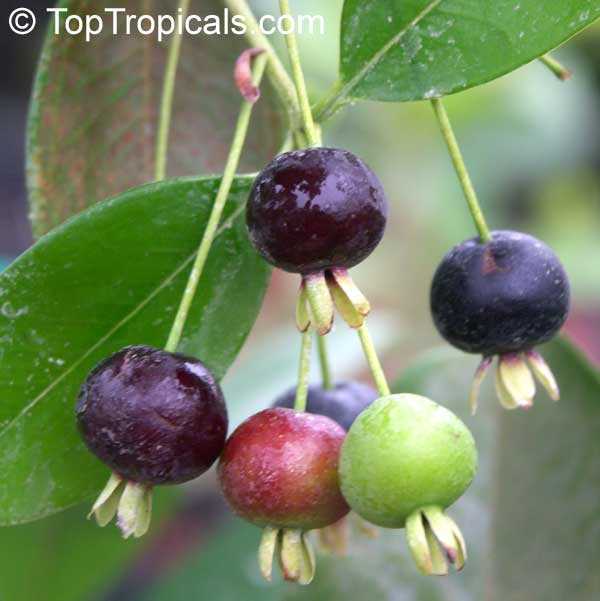
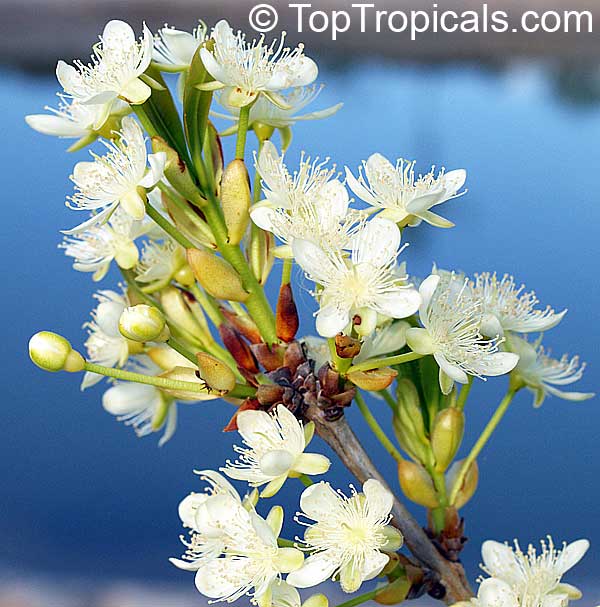
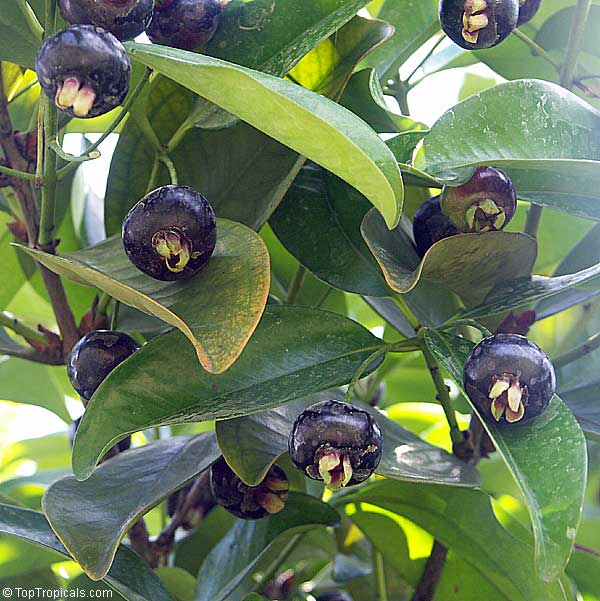
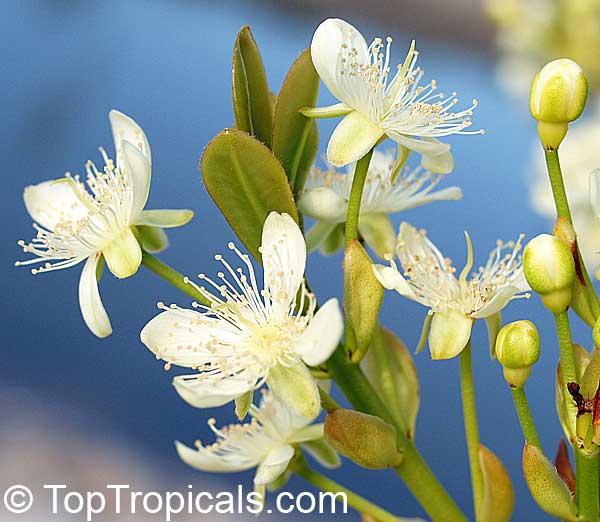
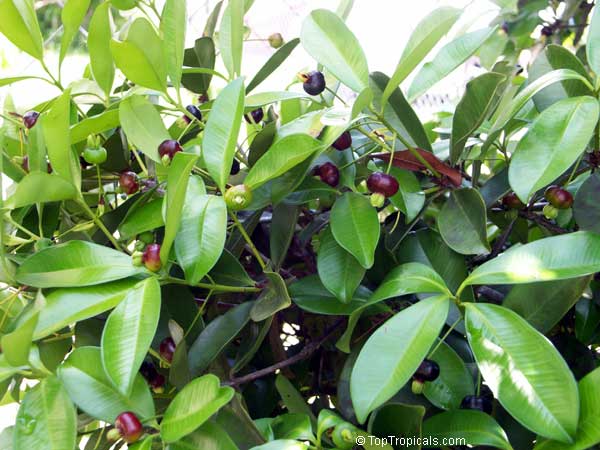
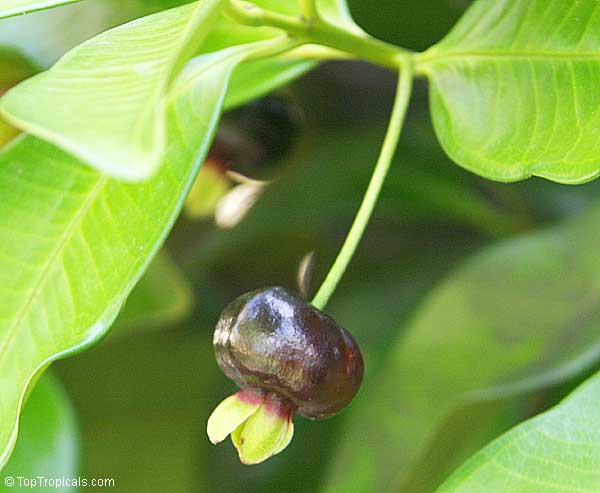
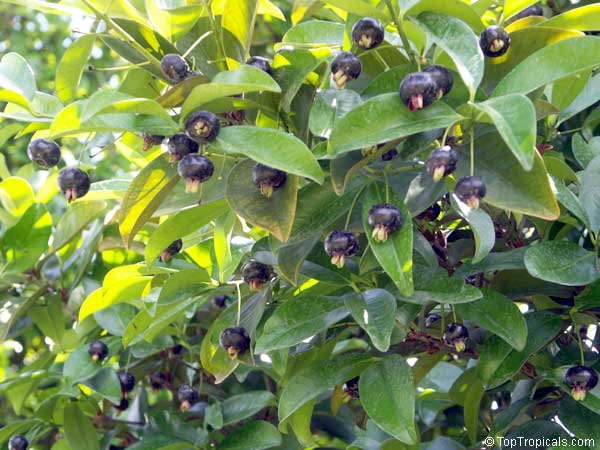
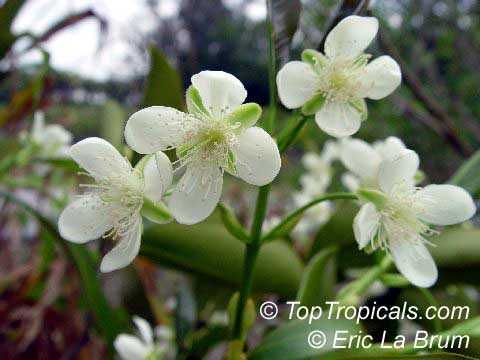
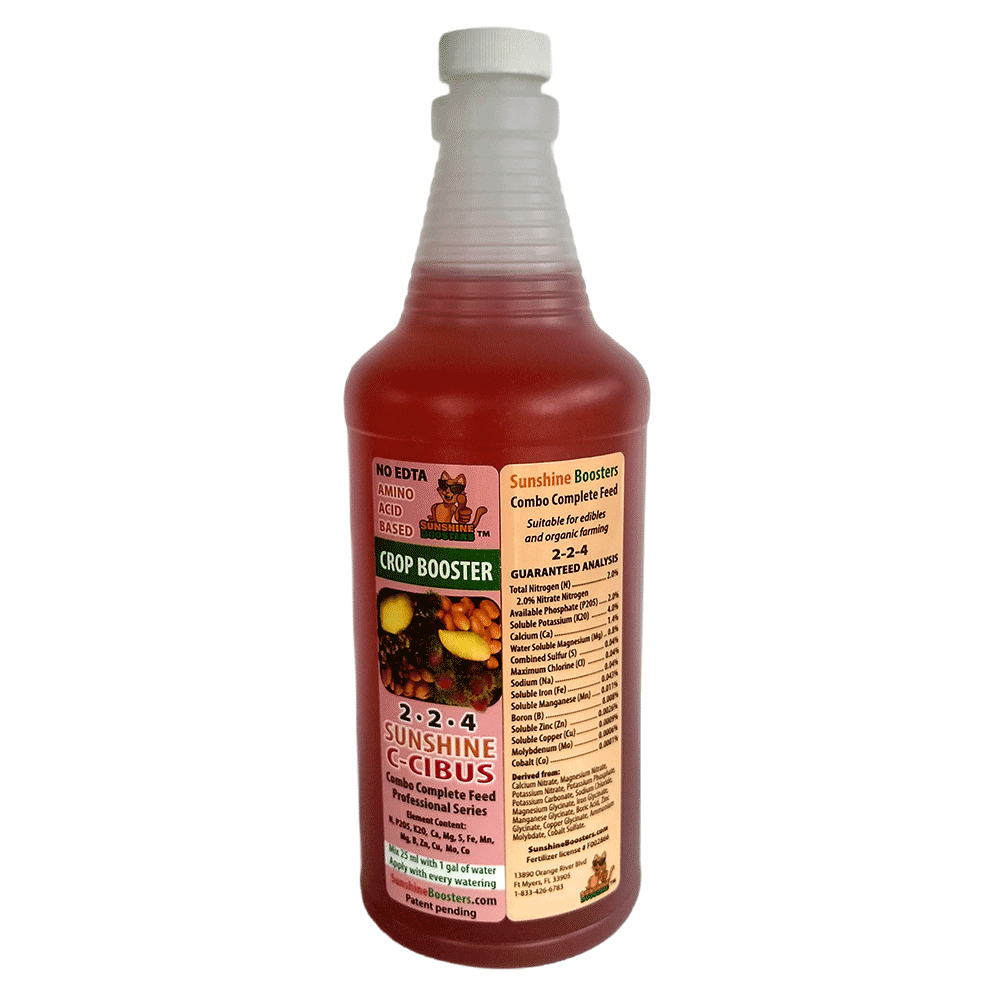 SUNSHINE C-Cibus (NPK 2-2-4) - Crop Booster for every watering.
SUNSHINE C-Cibus (NPK 2-2-4) - Crop Booster for every watering. 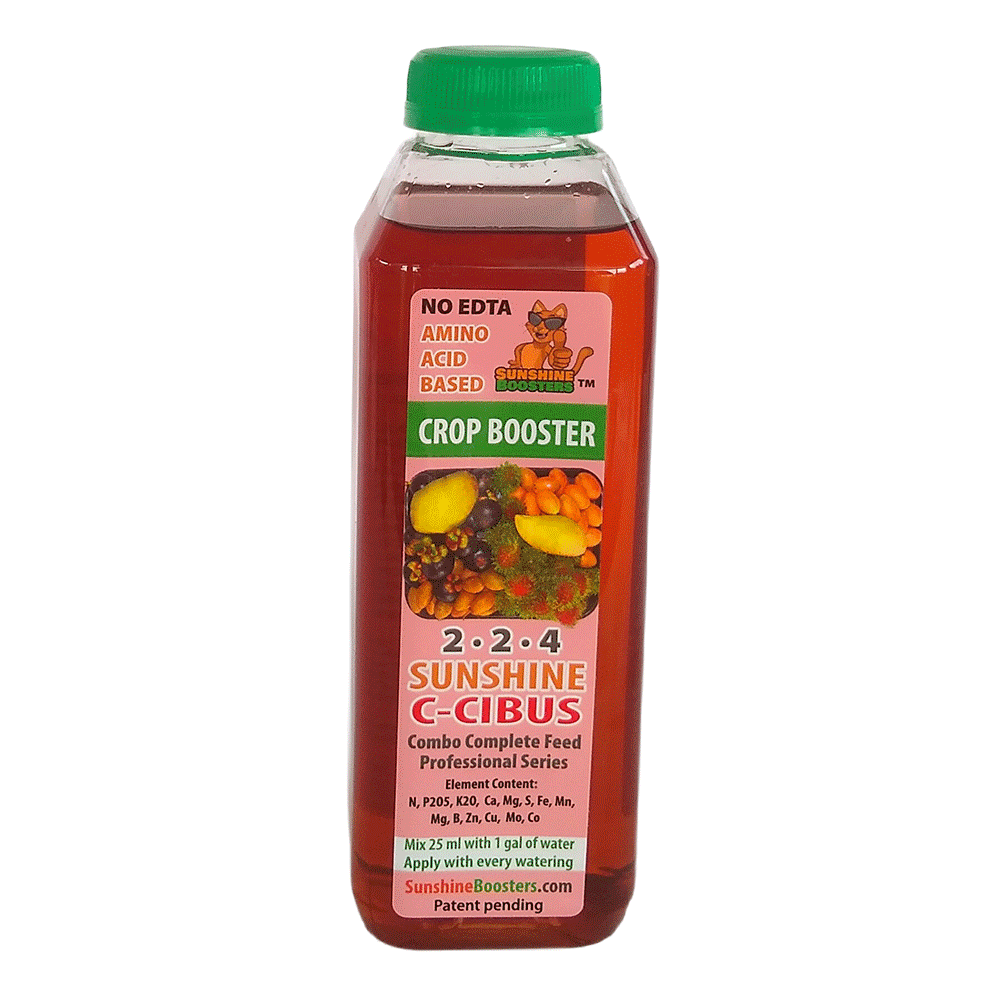 SUNSHINE C-Cibus (NPK 2-2-4) - Crop Booster for every watering.
SUNSHINE C-Cibus (NPK 2-2-4) - Crop Booster for every watering. 